March 18, 2021 - Naval Aviation Museum
Pensacola, Florida
|
| It's been over ten years since I've been to the Naval Aviation Museum in Pensacola. Link. I know they've added a big, new wing to it since then. Time to check it out! |
| |
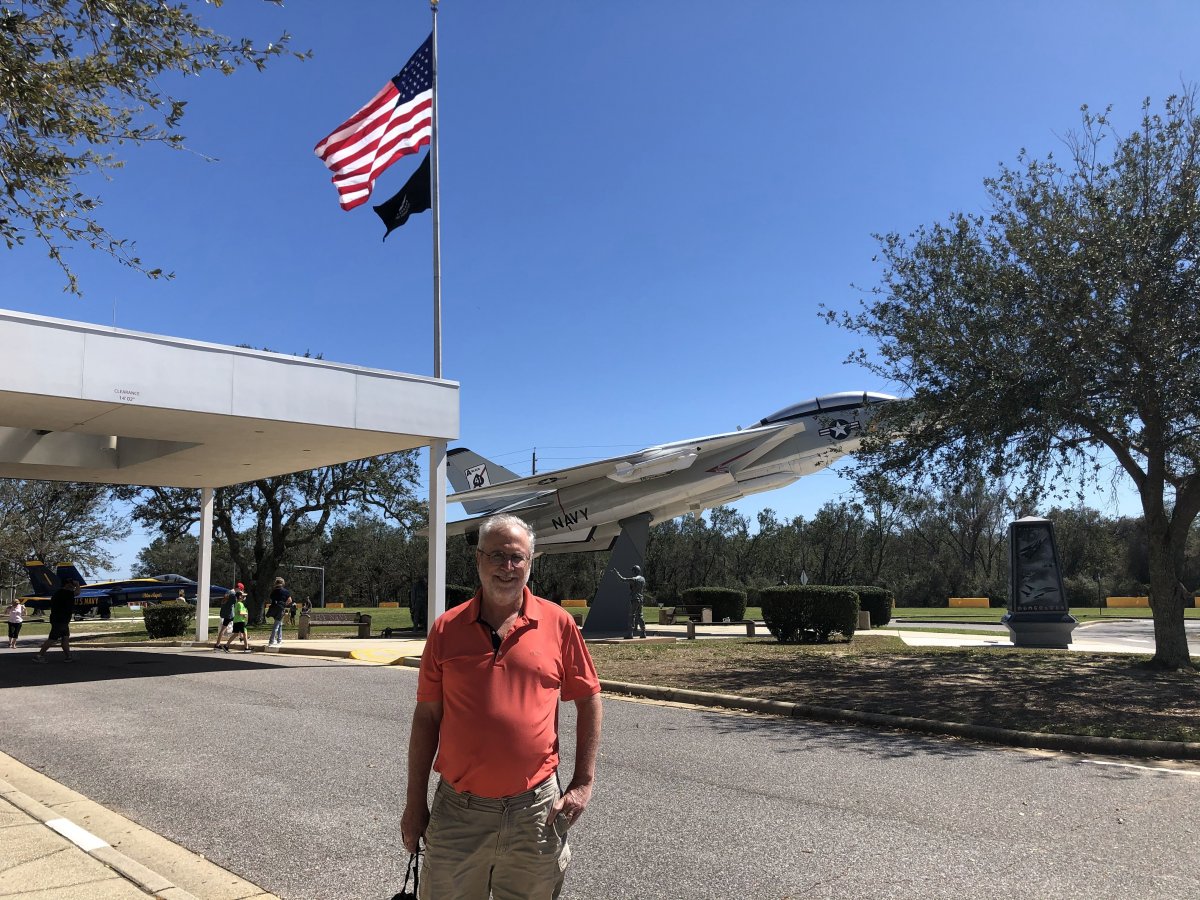 |
|
|
The entance to the museum. In the age of Covid, only millitary -- active and retired -- can get on the base to see the museum.
|
| |
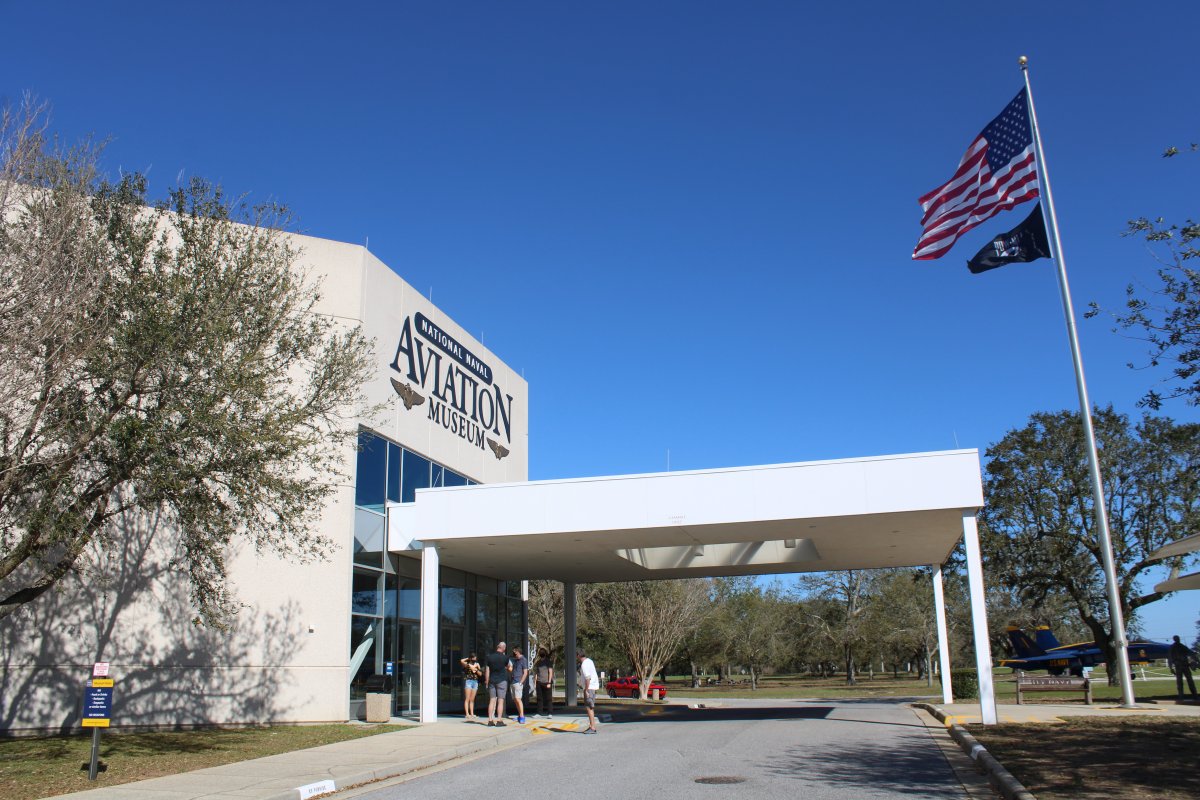 |
|
| The venerable F-14 Tomcat. The great plane made its first operational deployment in 1974 and was retired from the U.S. Navy in 2006. A 32 year run -- not bad. 712 were built. I think the Navy misses the long-range, high speed, and heavy weapon load capability that the F-14 had. |
| |
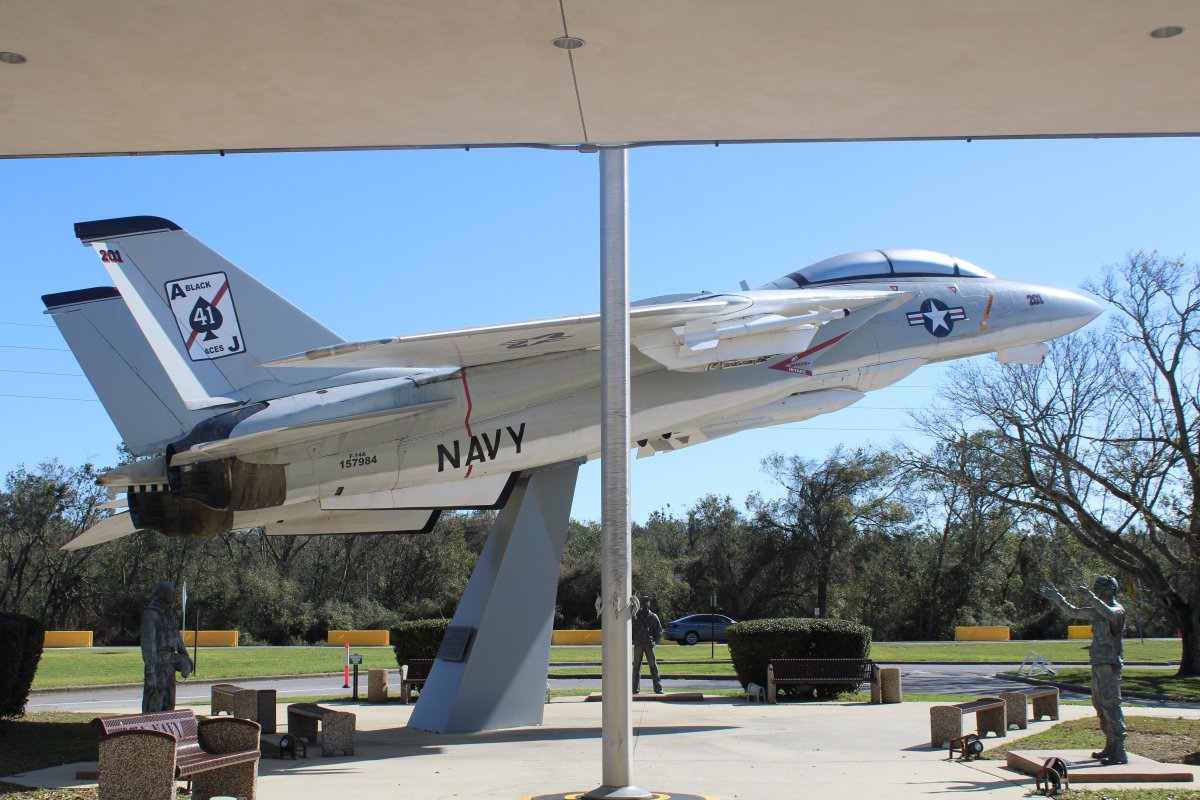 |
|
|
Huge anchor from an aircraft carrier.
|
| |
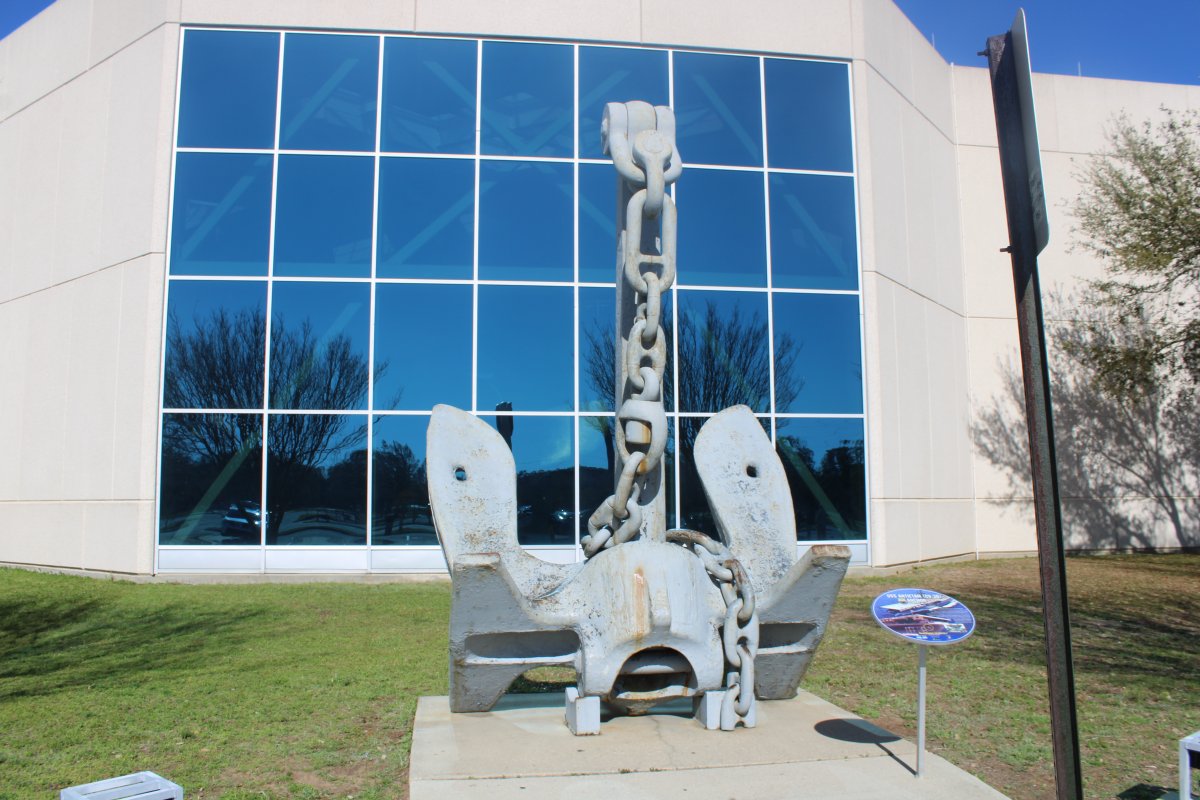 |
|
| Four Blue Angel A-4 Skyhawks fly close formation overhead in the brightly lit atrium. This is how close the Blue Angels actually fly. Amazing. |
| |
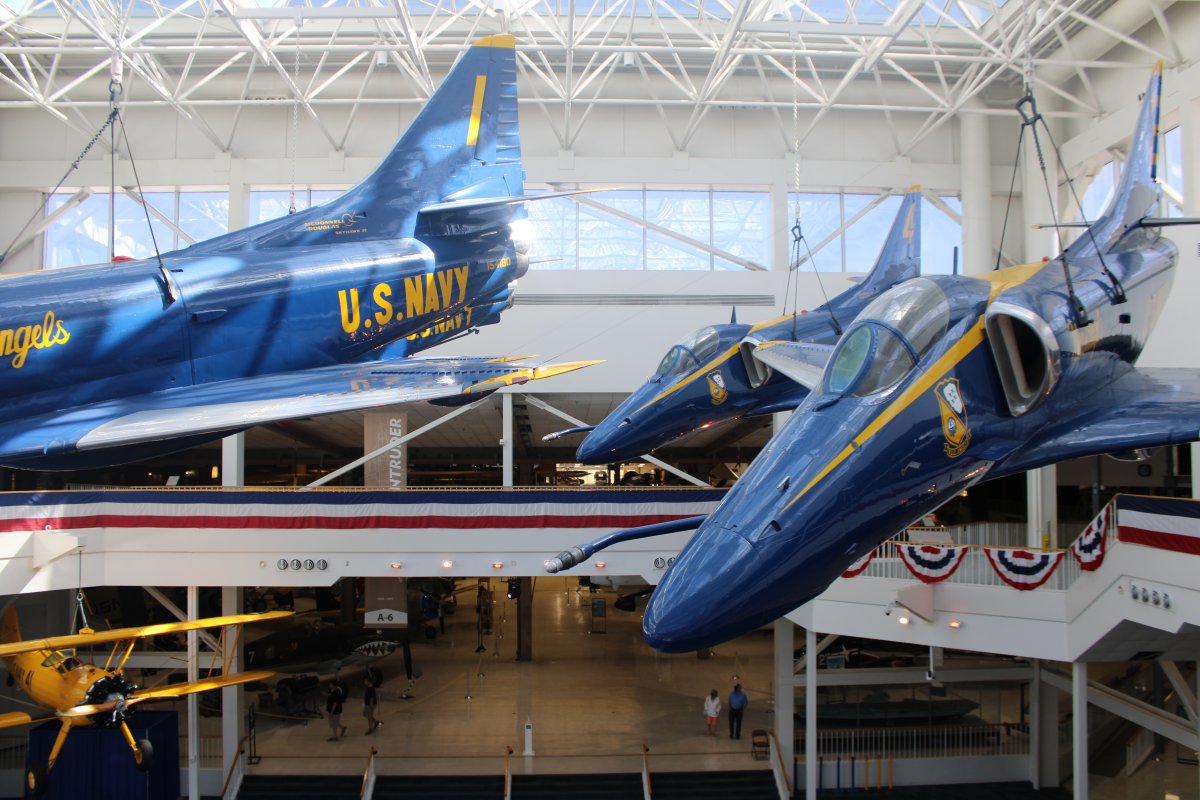 |
|
| From another angle. |
| |
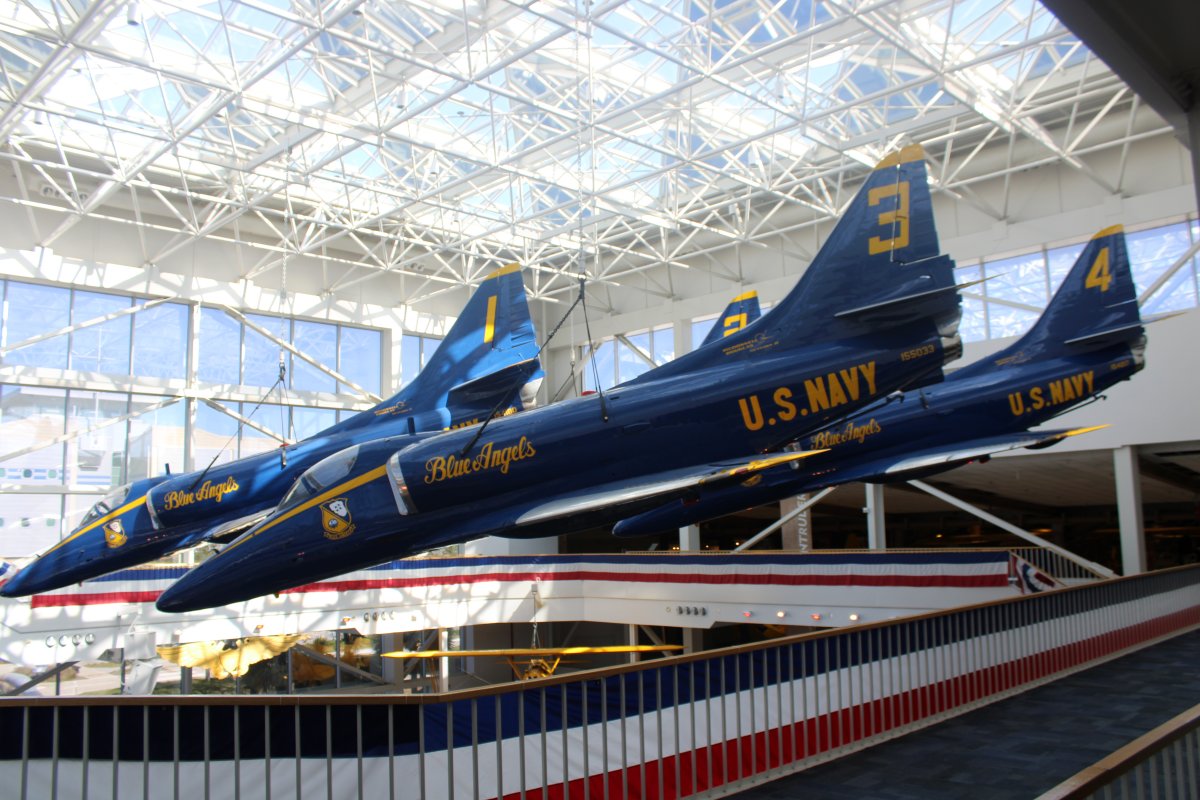 |
|
|
This is what I wanted to see the most: the massive P-5M Marlin flying boat. 258 were built but this is the last one that exists. It is so big, the museum couldn't keep it inside, so it sat outside and deteriorated in the weather for years. But now with the new wing, it sits inside protected with a gleaming fresh paint job. Why the interest in this plane? My Dad used to fly these planes out of Bermuda with VP-49 in the late 1950s.
Lynnette at lower left gives you an idea of how big the Marlin is.
|
| |
 |
|
|
The P5M was introduced in the US Navy in 1952 and retired in 1967.
Notice the high mounted T-tail. That's because this is a P5M-2, the second generation of Marlins. My Dad flew the first generation of Marlins, the P5M-1, with the horizontal stabilizer and elevator at the base of the vertical stabilizer and rudder.
|
| |
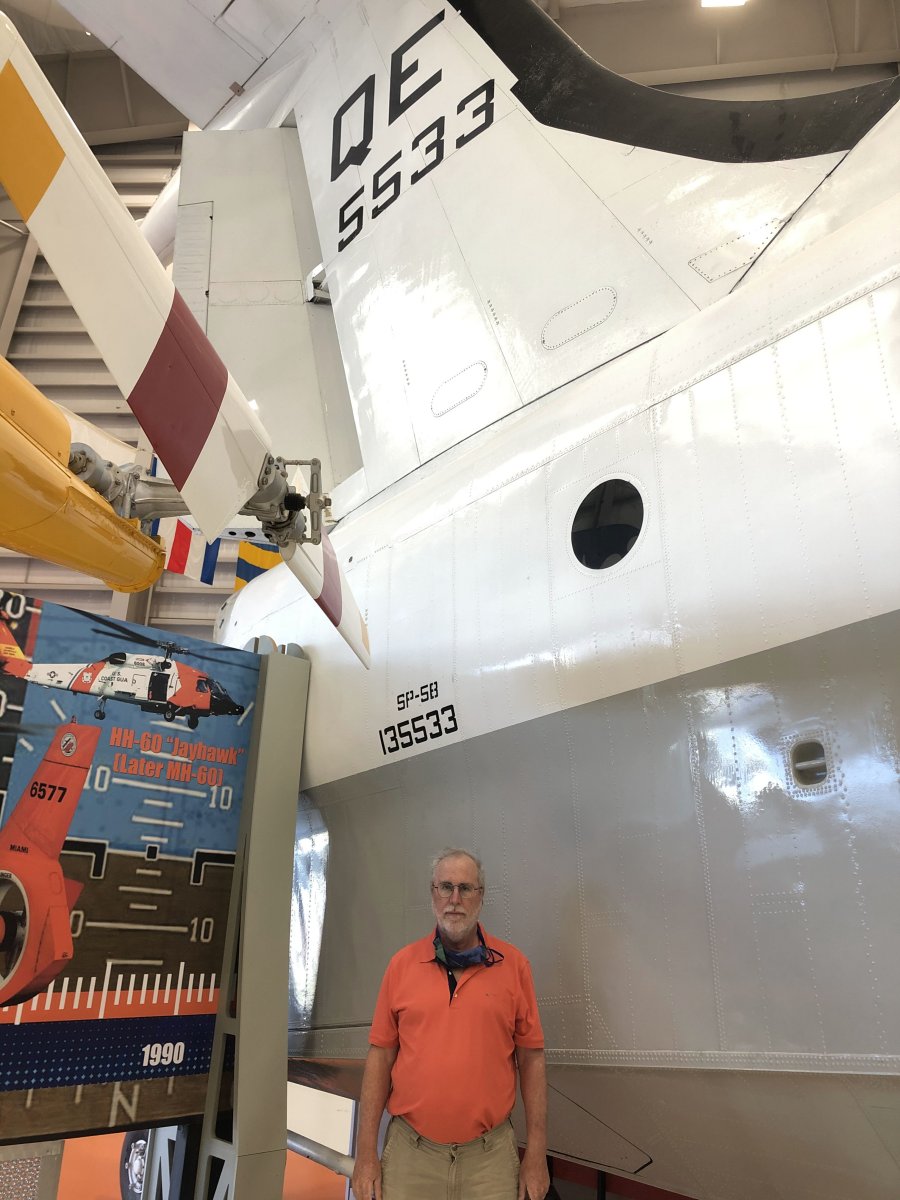 |
|
| All the Marlins were built by the Glenn L. Martin Company of Middle River, Maryland, where Martin State Airport is now, just a couple of miles from Essex Skypark where I base my plane. |
| |
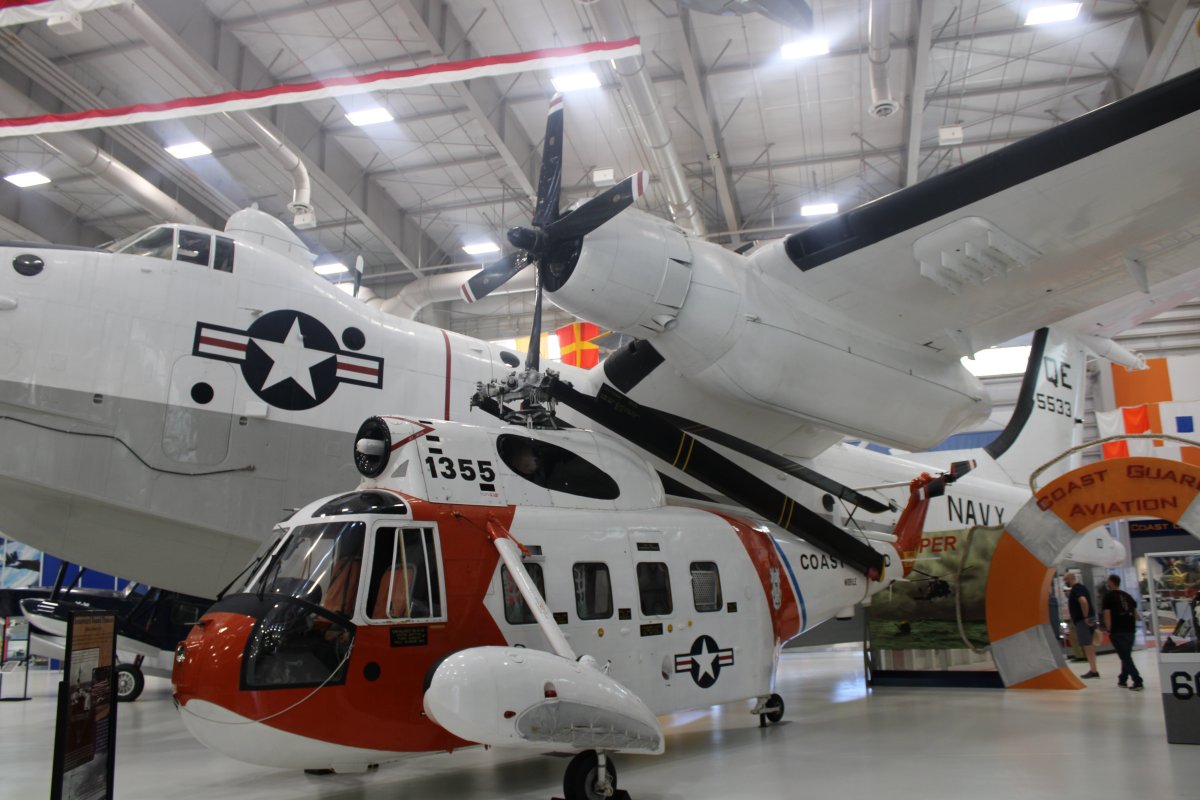 |
|
|
Looking up at the Marlin cockpit. My Dad would have loved to have seen this plane in its new setting.
|
| |
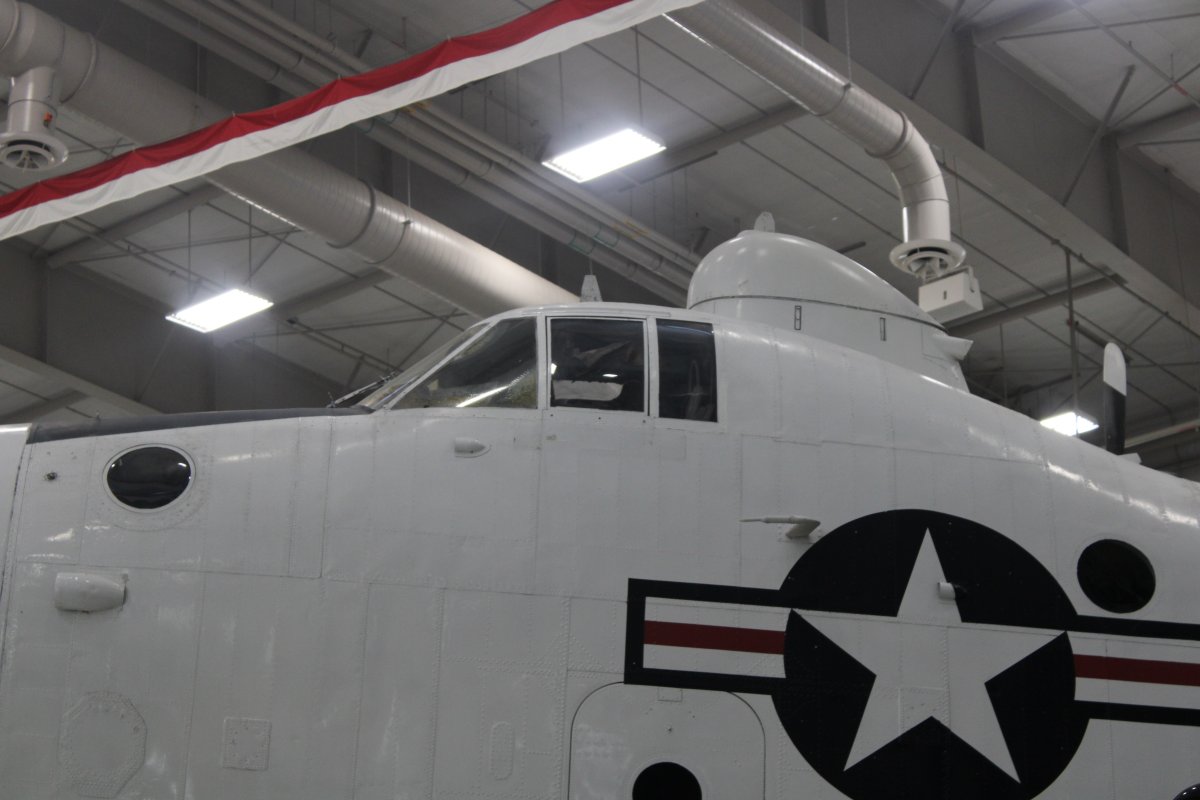 |
|
|
The P5M was powered by two Wright R-3350-32WA Duplex-Cyclone 18-cylinder air-cooled radial piston engines with water injection, providing 3,250 horsepower each. This engine was also used in the B-29 Superfortress, the F8F Bearcat fighter, the Hawker Sea Fury and the Lockheed P-2 Neptune.
The main gear -- called beaching gear -- were detachable. The Marlin would land on water, the gear would be brought out to the plane in boats and attached to the fuselage. Then the plane would taxi up out of the water via the ramp. Notice the beaching gear flotation tank, painted red -- since its on the port side. There was also a tail beaching gear.
|
| |
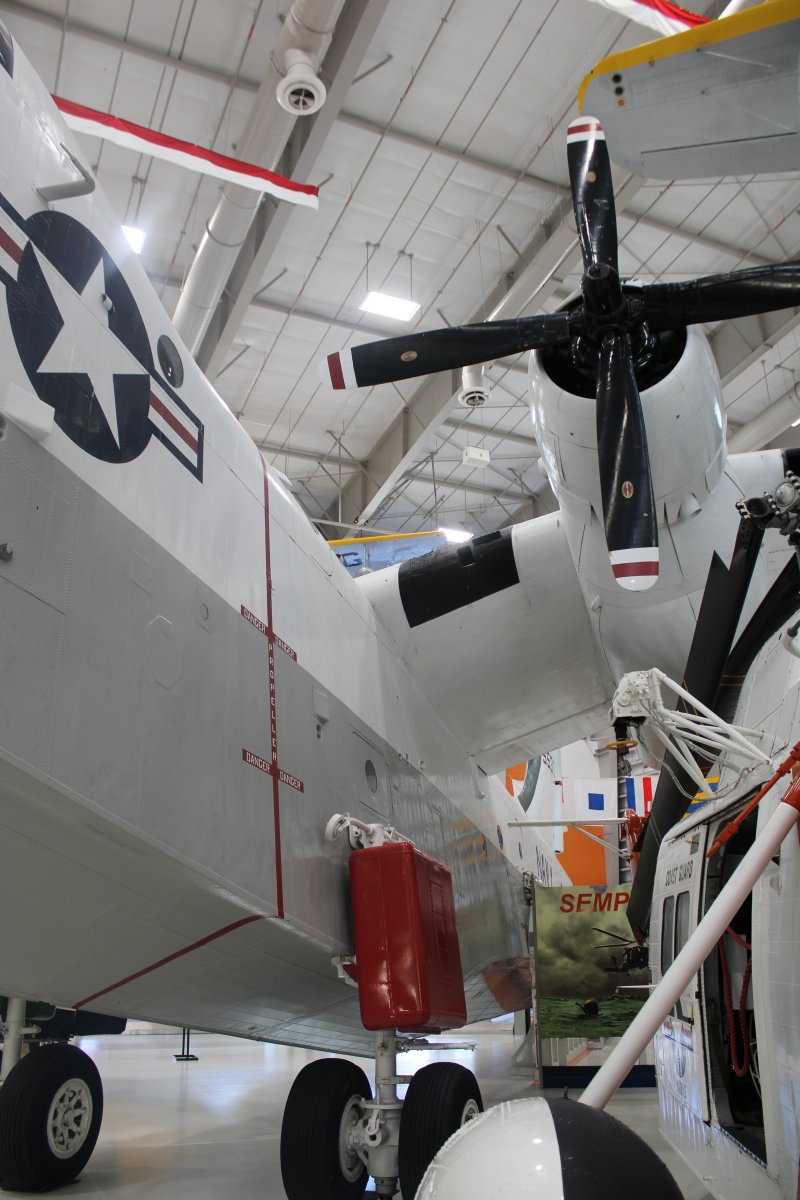 |
|
| Gigantic wingtip floats. |
| |
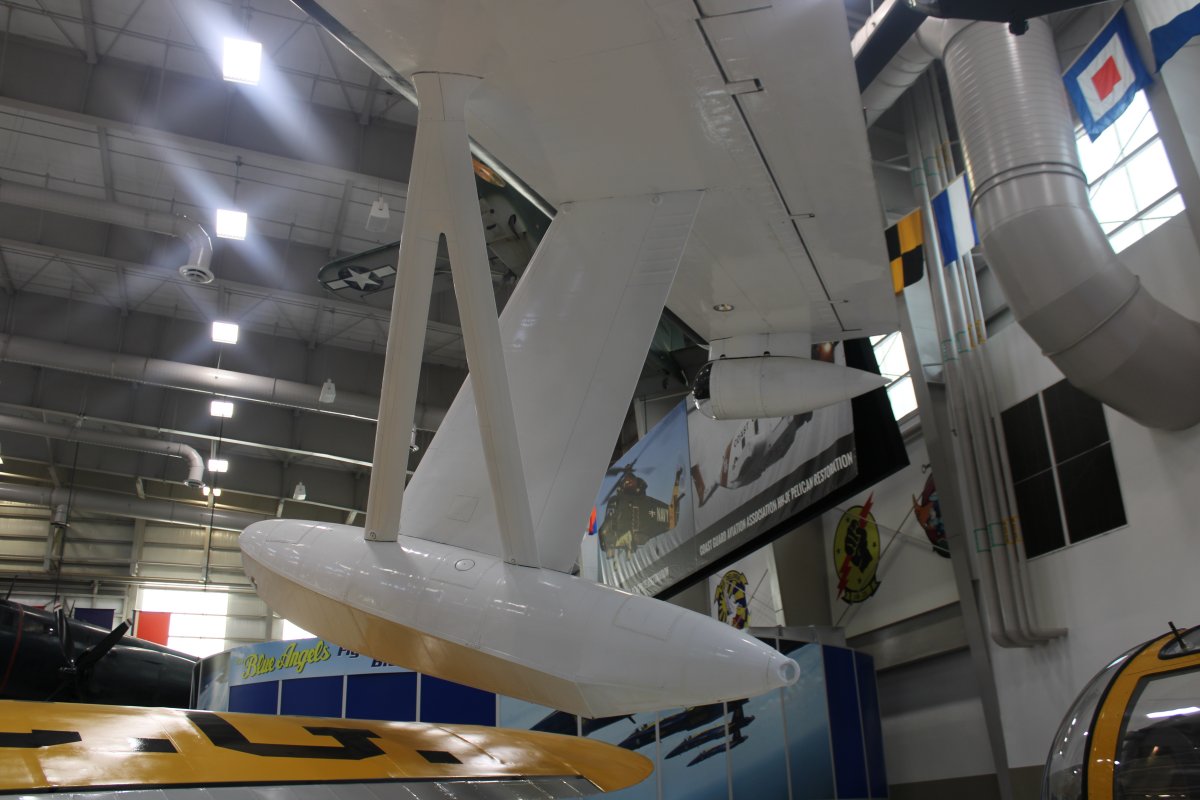 |
|
| The new museum wing contains most of the newer stuff: the Vietnam War-era and beyond jets, prop-planes and helicopters. |
| |
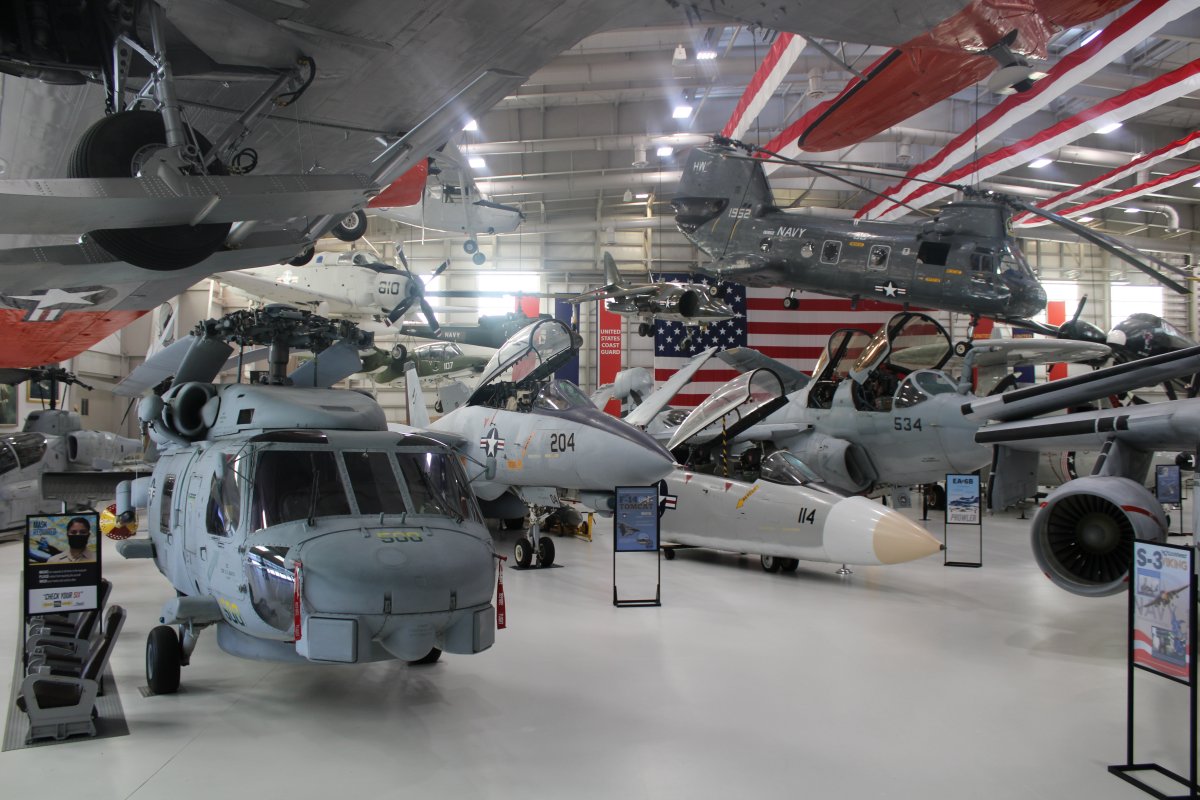 |
|
A newer variant of the Navy's airborne early warning E-2 Hawkeye. First plane to launch off the carrier and last to recover. |
| |
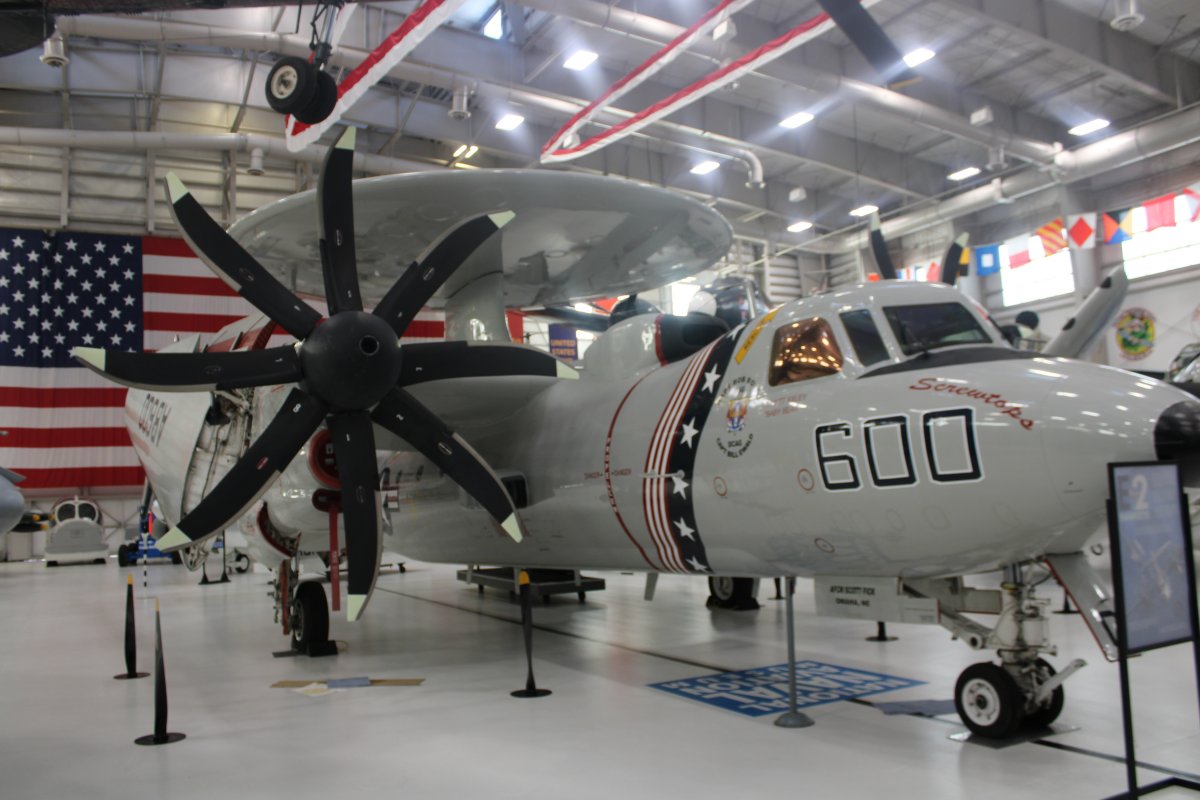 |
|
| A squadron's deployment car! |
| |
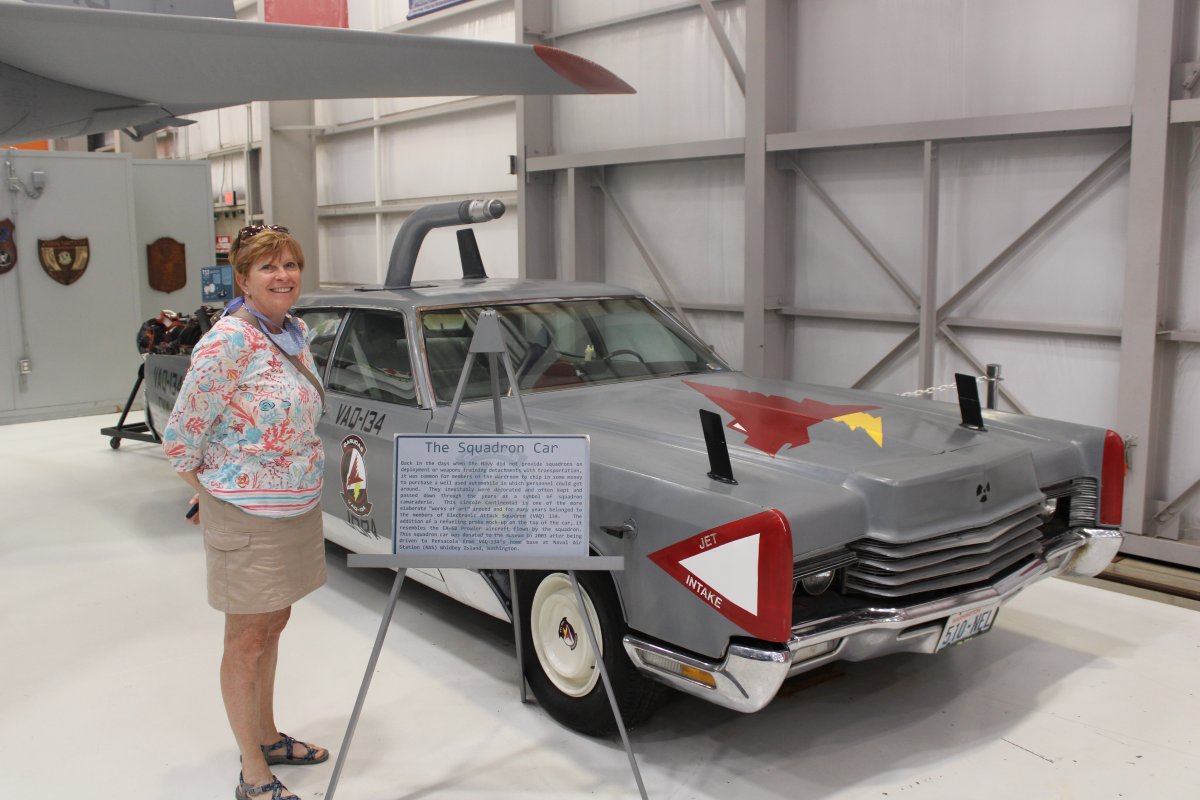 |
|
|
A combat veteran: A-7 Corsair.
|
| |
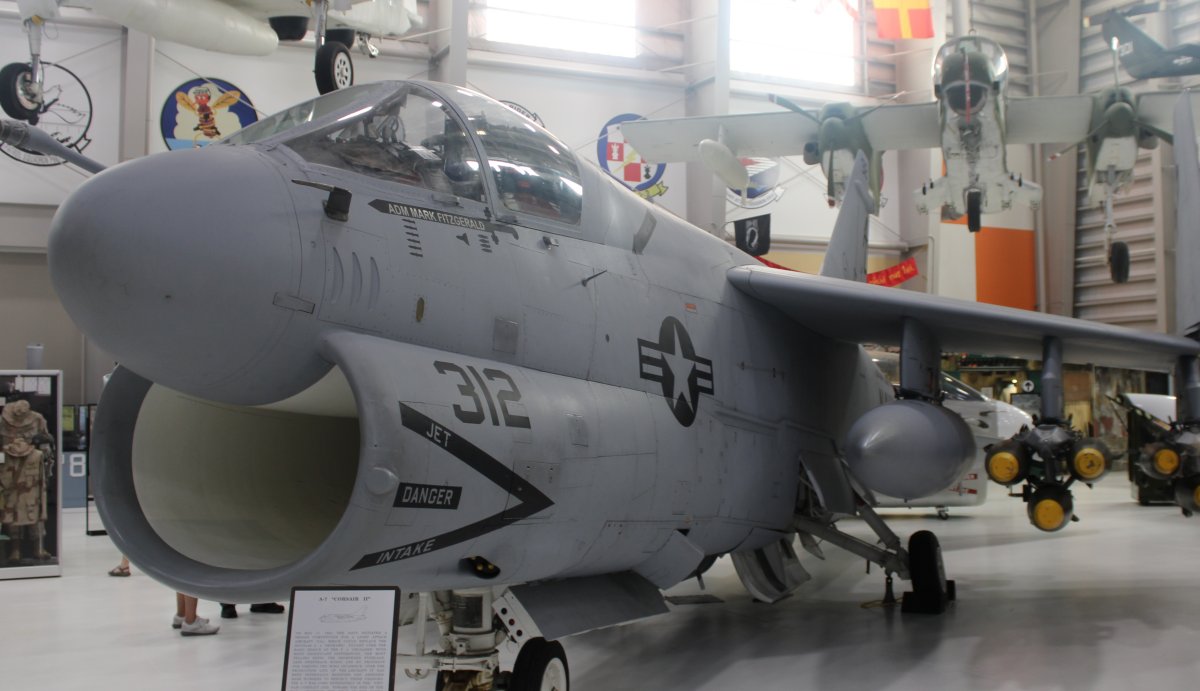 |
|
| SH-60 Lamps helicopter. |
| |
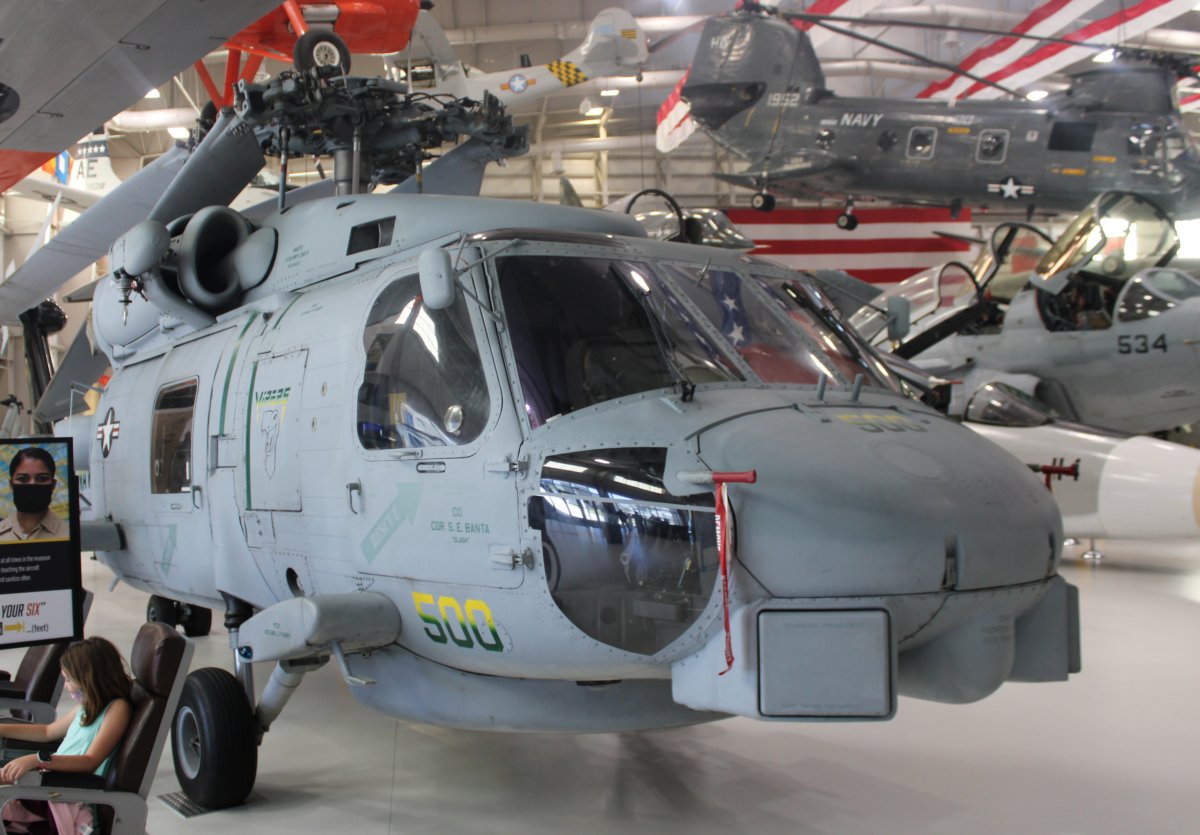 |
|
| I remember this plane from previous visits to the museum. During the last days of South Vietnam, a South Vietnamese pilot loaded up his family in this plane and flew out to a U.S. aircraft carrier offshore. He was able to land this plane on the flight deck. |
| |
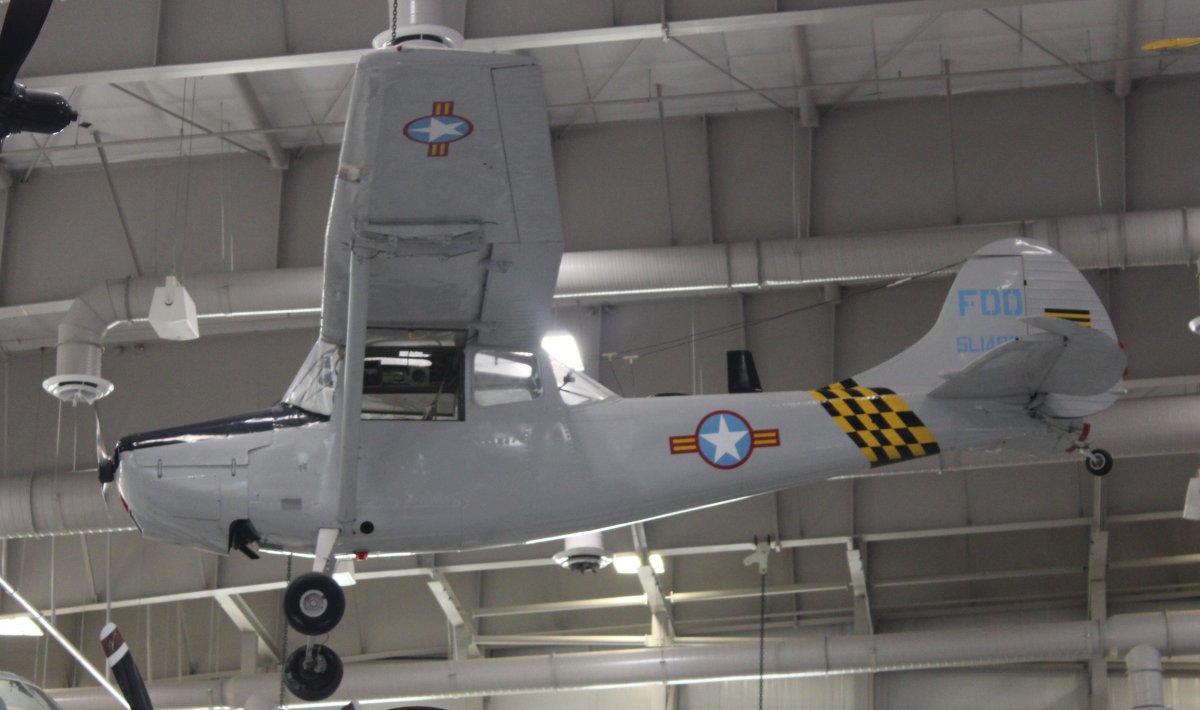 |
|
| Marine One helicopter. |
| |
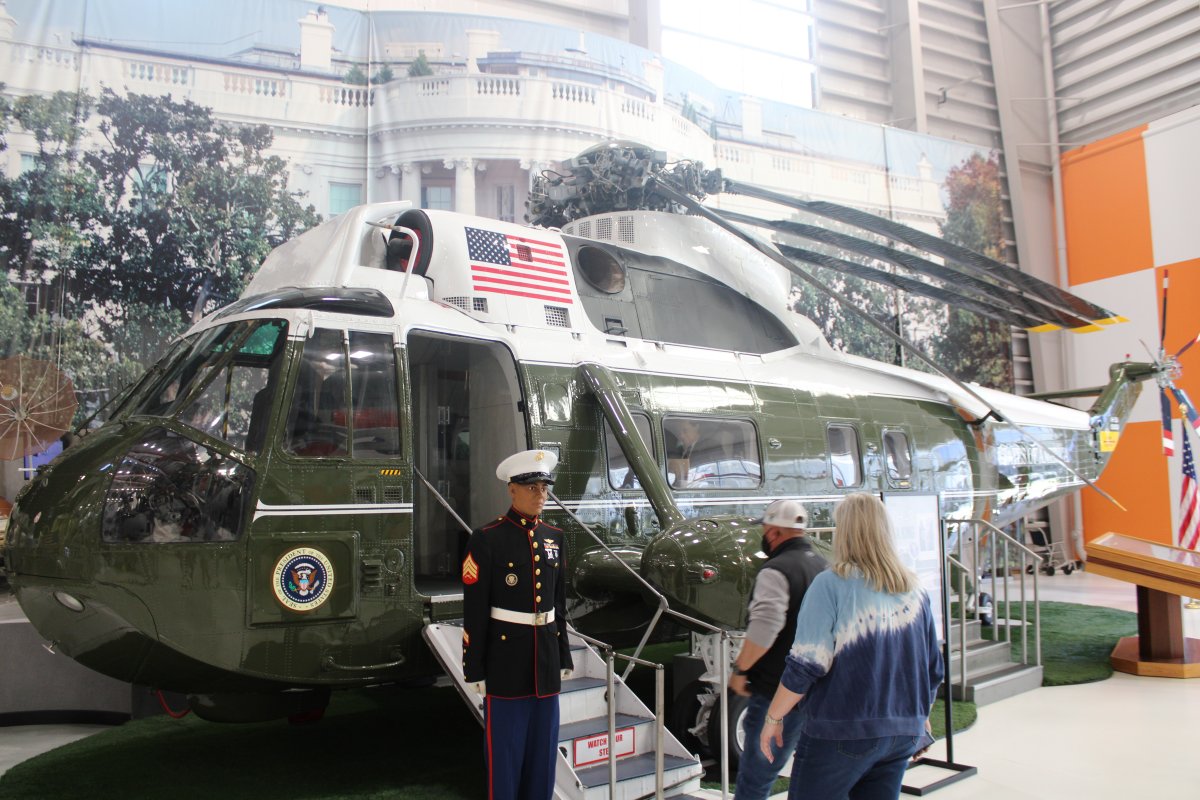 |
|
|
Now I'm over in the main museum area which contains everything from the beginning of Naval Aviation to the Korean War era.
Here is one of the all-time greats: the SBD Dauntless dive-bomber.
|
| |
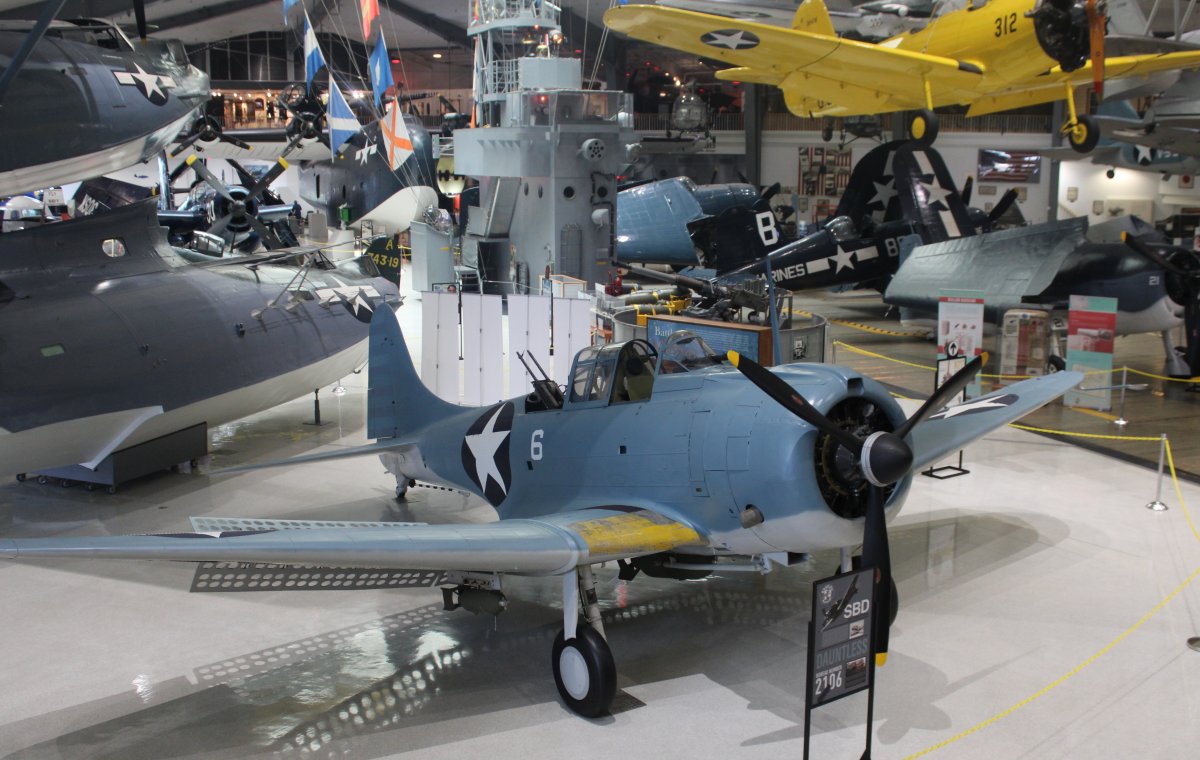 |
|
|
Head on view of the Dauntless.
|
| |
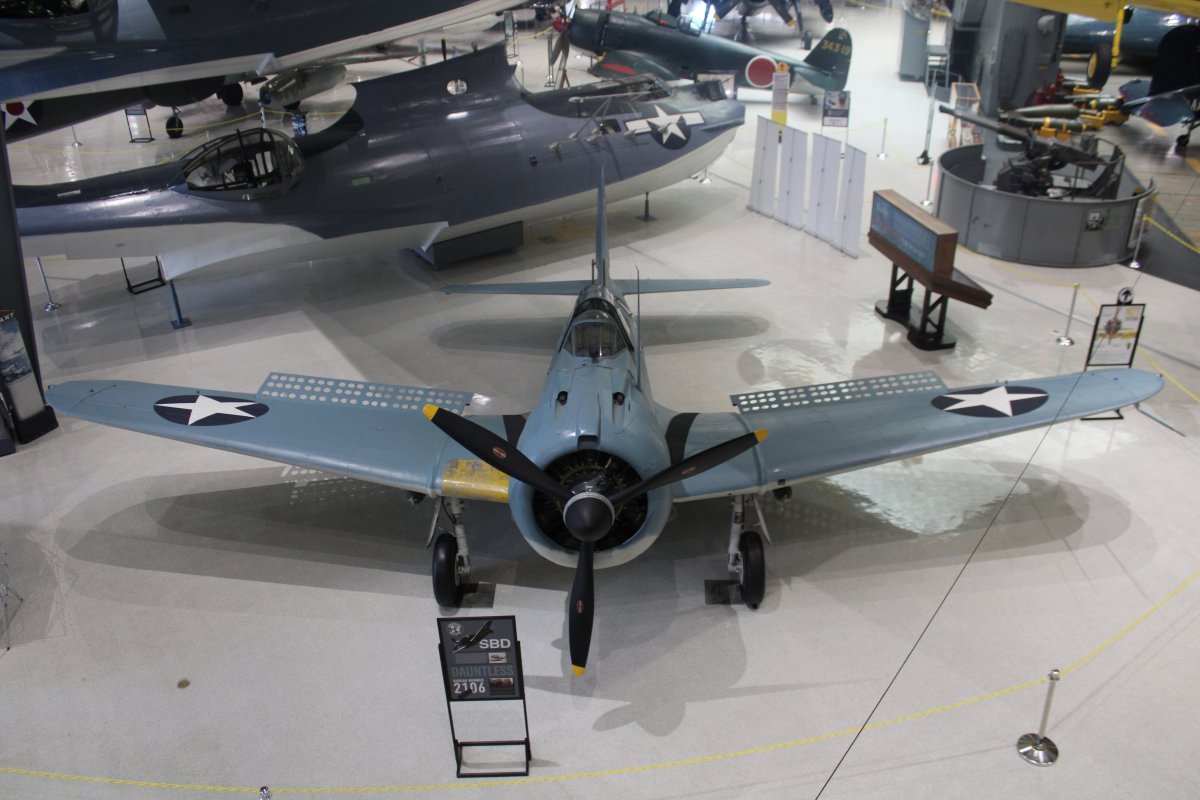 |
|
|
This particular aircraft has an amazing history. It was present at Pearl Harbor on December 7, 1941 and survived the Japanese attack. In early March, launching off the U.S.S. Lexington, it participated in a raid on Japanese airbases at Lae and Salamaua in New Guinea. Finally, flown by Marines off the island of Midway, it attacked the Japanese aircraft carrier Hiryu on June 4 and was punctured with over 200 bullet holes. It is the only known existing surviving aircraft of the Battle of Midway.
Repaired after Midway, the Dauntless was used for aircraft carrier landing training on Lake Michigan where it crashed into the water in June 1943. After it was recovered from Lake Michigan, 70,000 hours were spent on the restoration.
|
| |
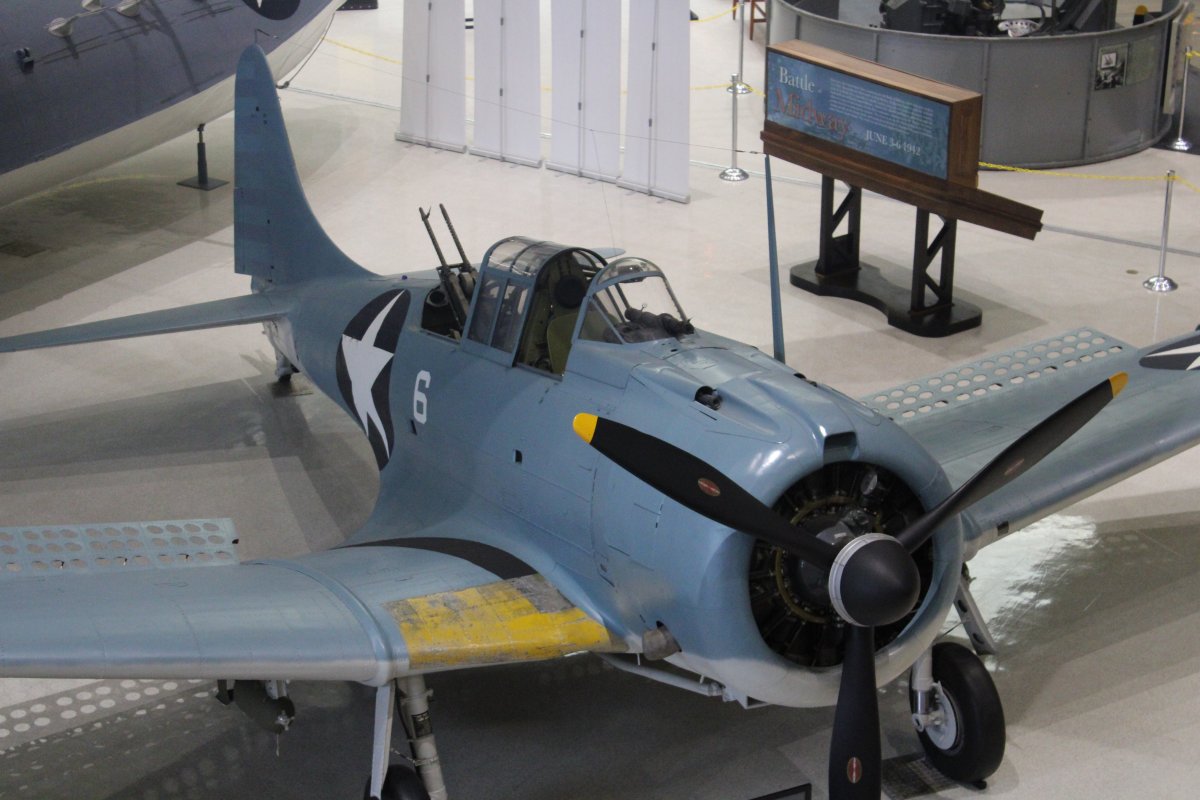 |
|
|
A neat display of a PBY Catalina flying boat with the entire side of the aircraft cutaway so you cold see inside.
|
| |
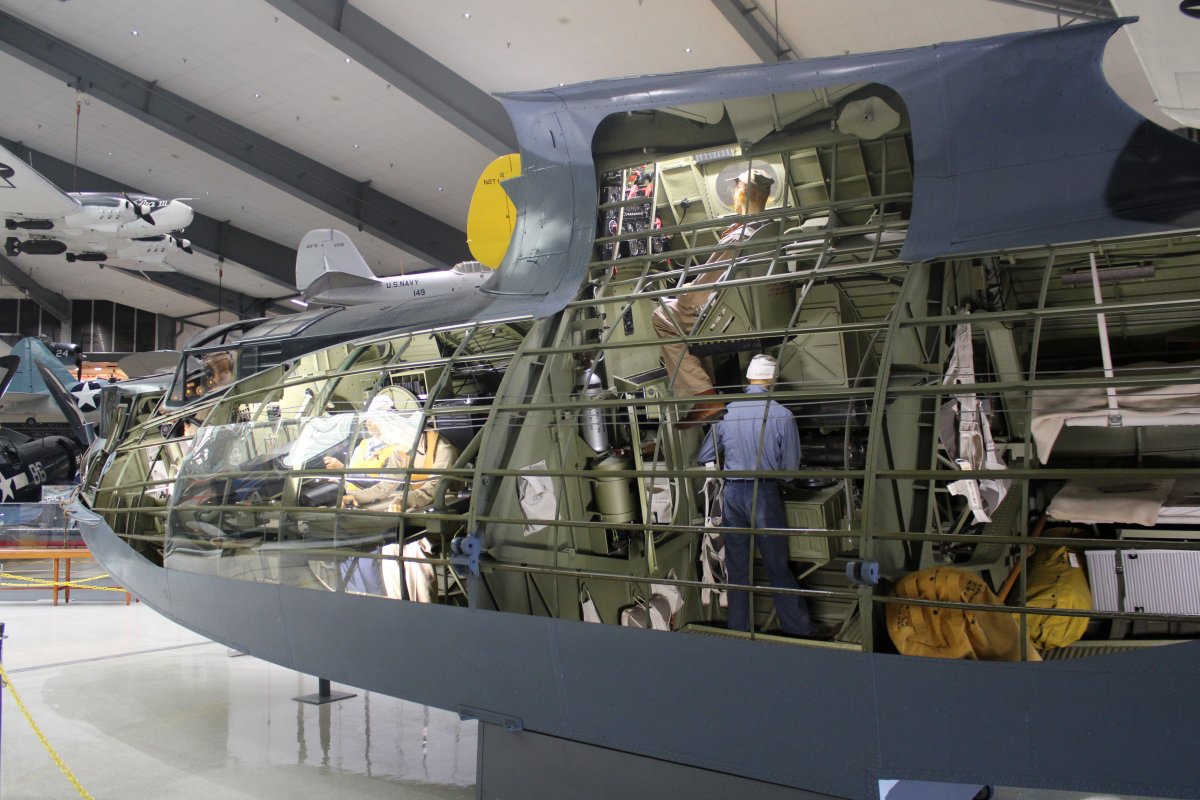 |
|
| Cockpit and forward area. |
| |
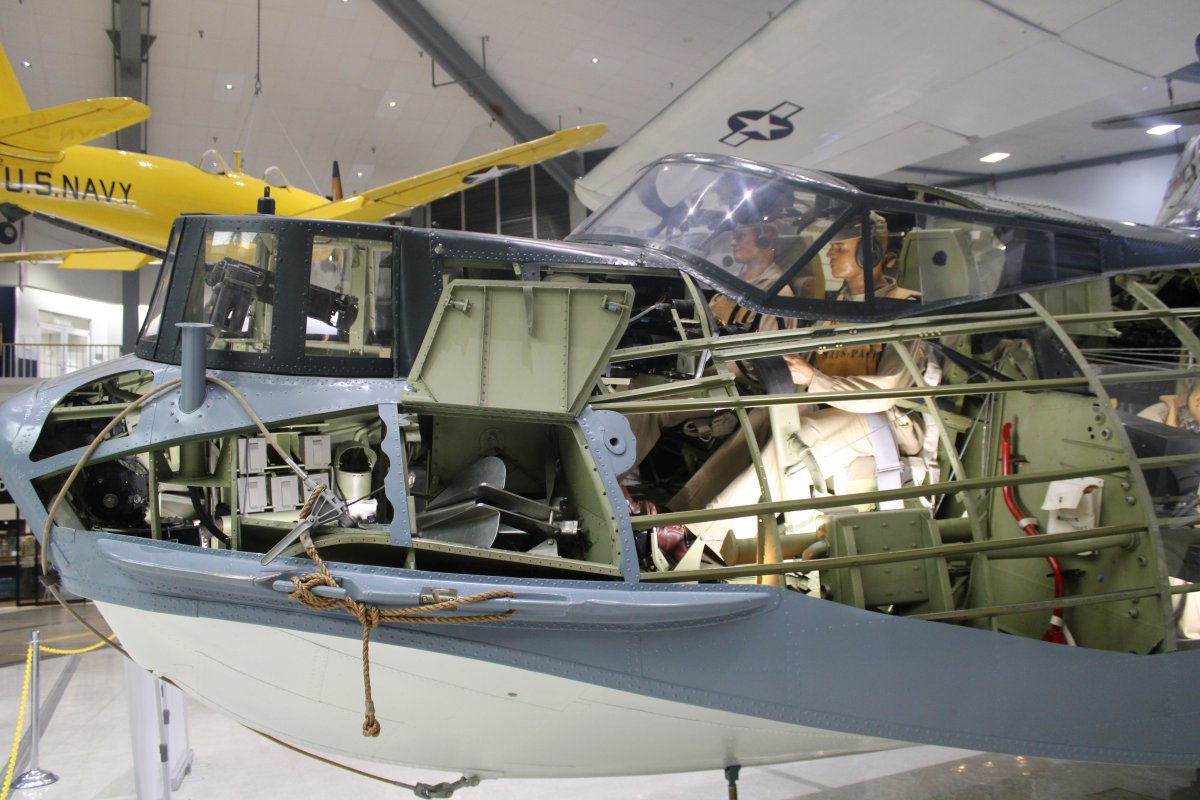 |
|
| Aft area. If it was like the P-3, only the pilots and flight engineers got to use the bunks. |
| |
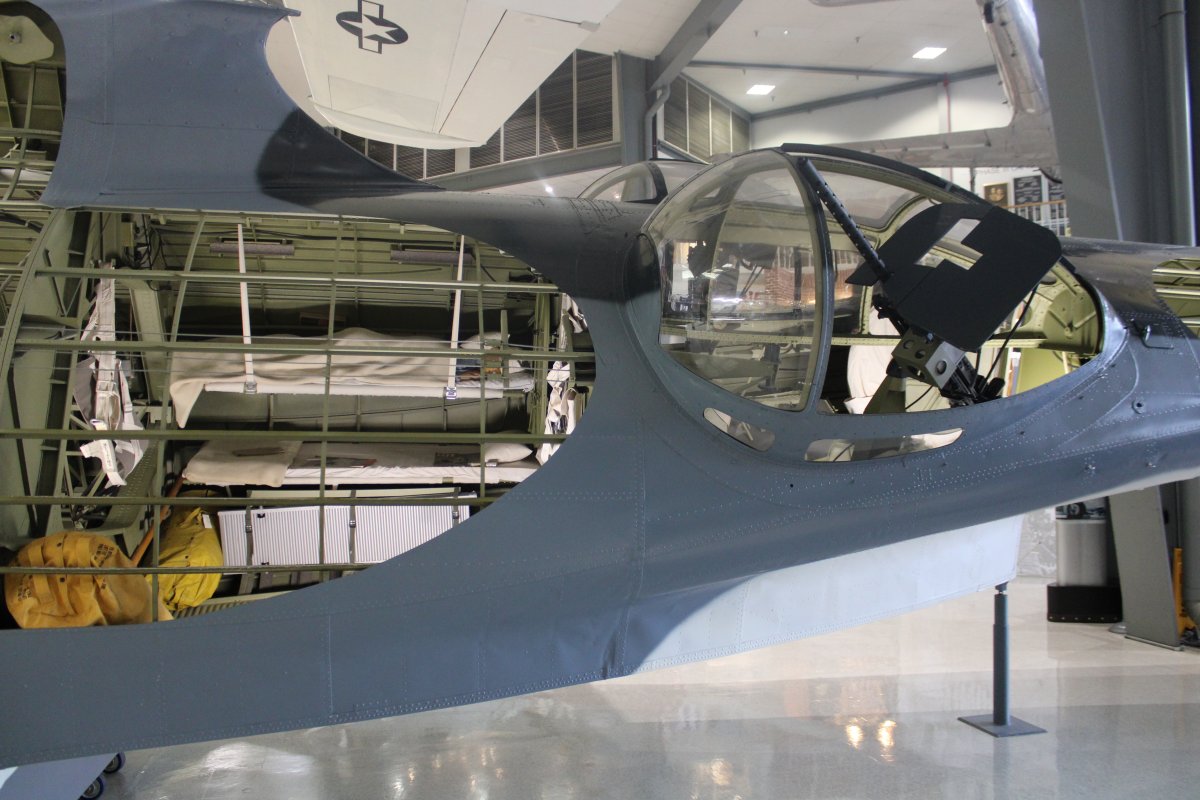 |
|
| As World War II progressed, American ships were fitted with awesome anti-aircraft firepower. This Bofors 40mm twin gun was one of the most effective types. It could fire at a rate of 160 rounds per minute. |
| |
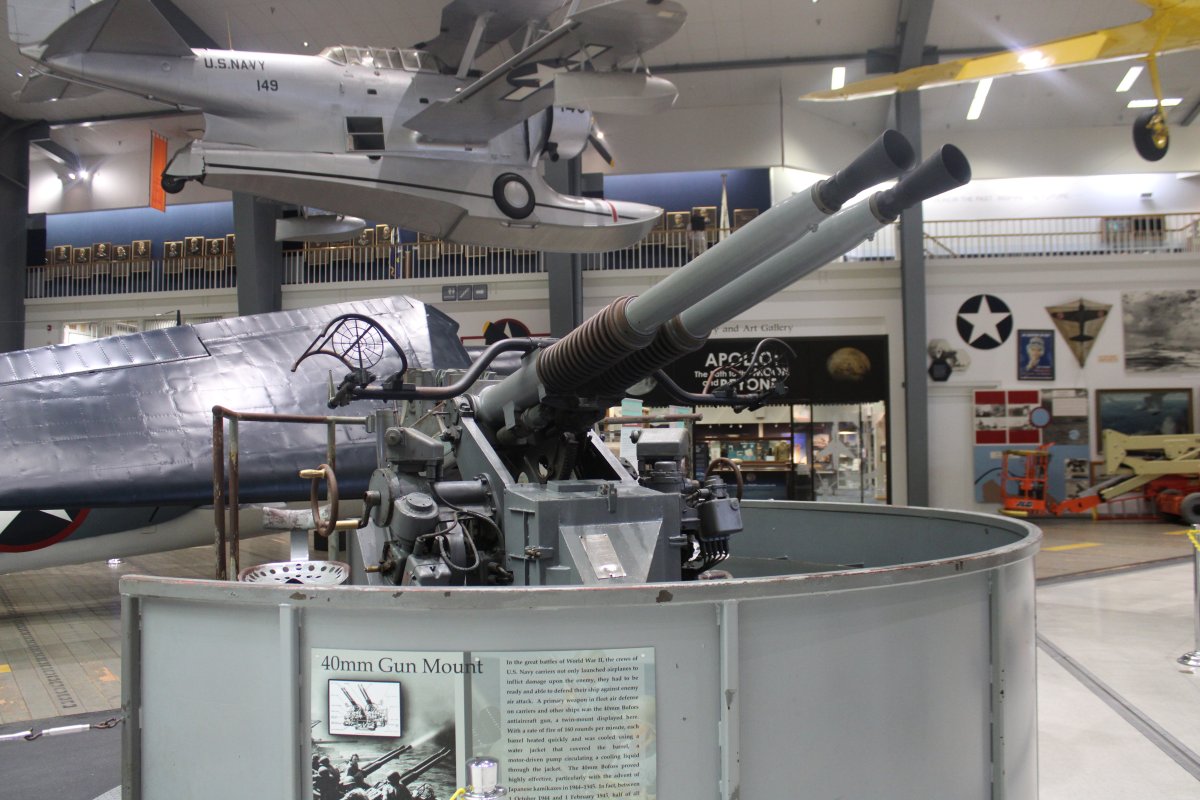 |
|
|
The primary US Navy fighter plane for nearly the first two years of the war: the Grumman F4F Wildcat.
|
| |
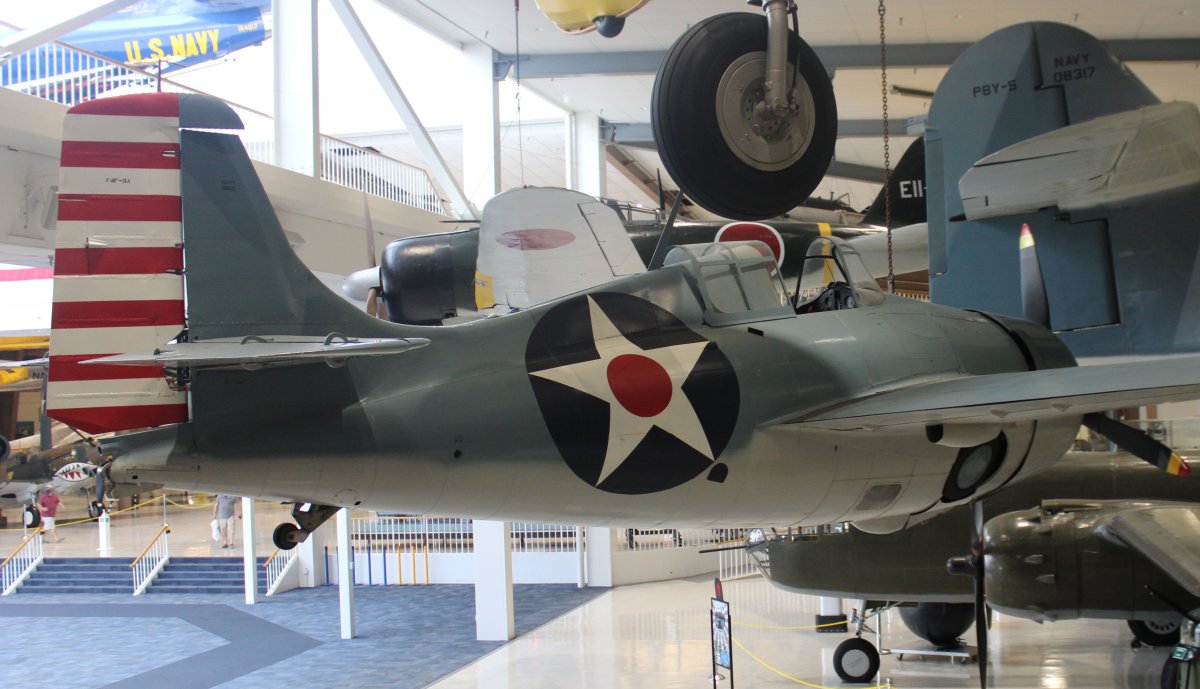 |
|
| The primary Japanese fighter of World War II: the Zero. |
| |
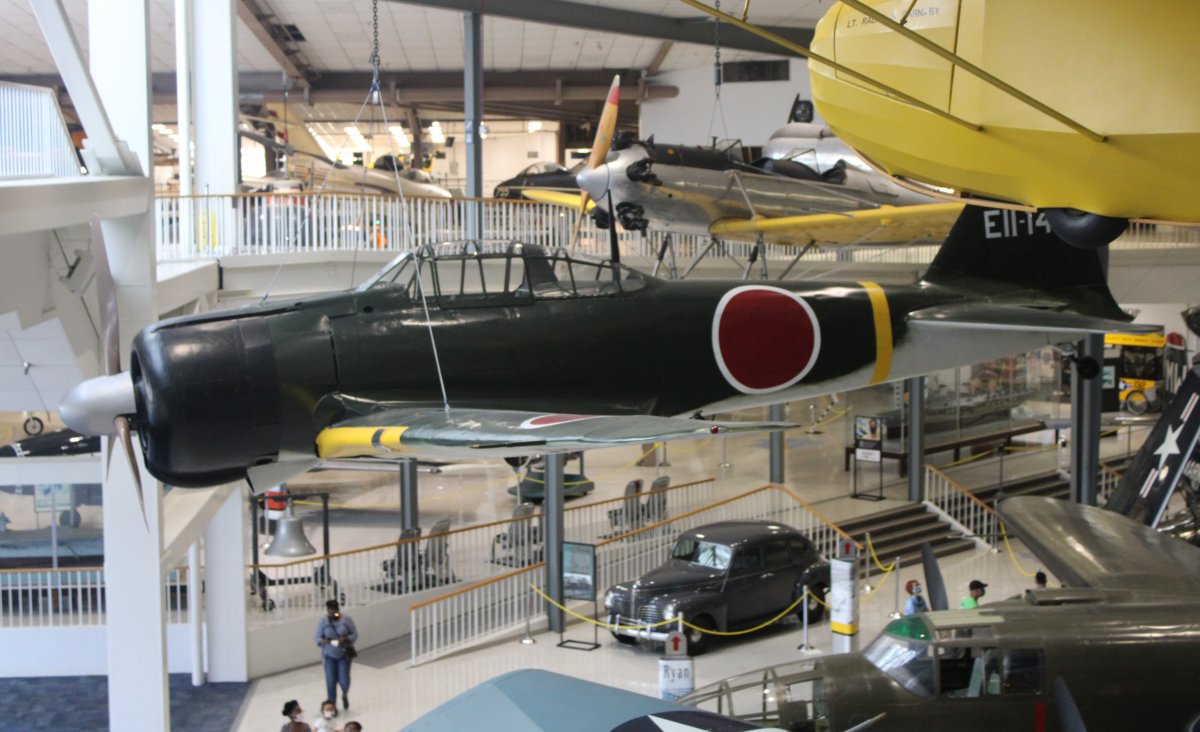 |
|
|
Zero's are very rare.
|
| |
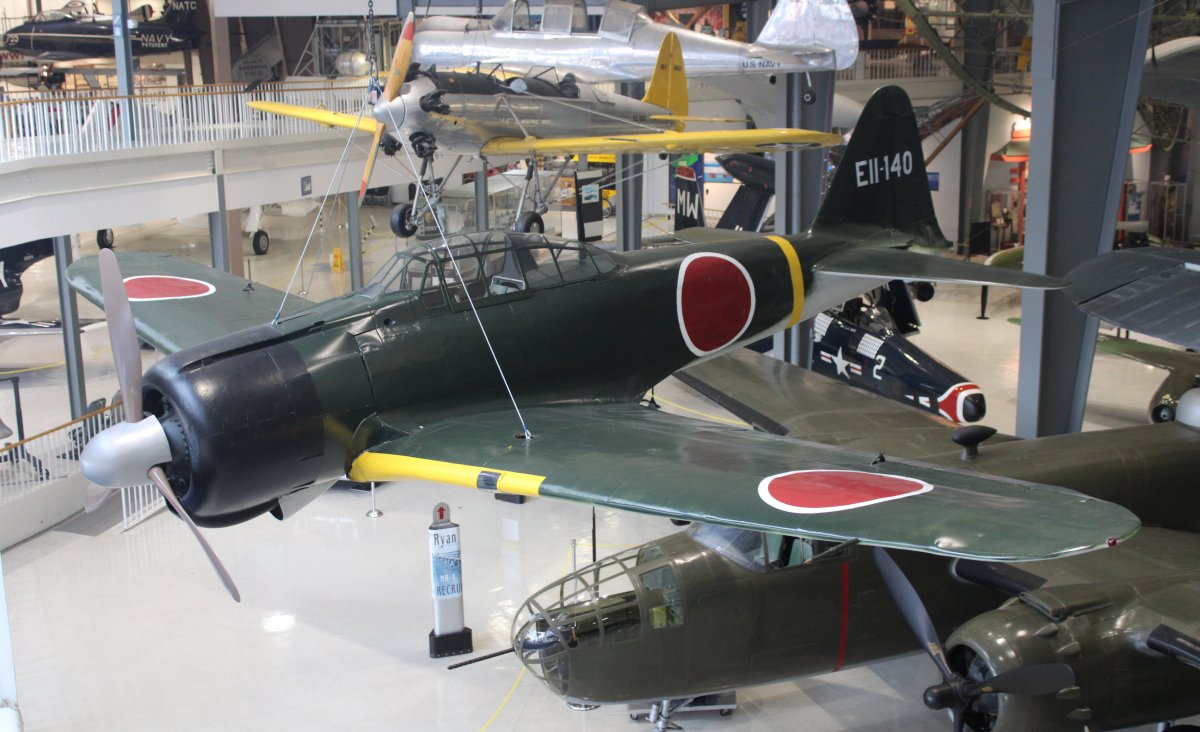 |
|
| A good look at the top of the Zero. |
| |
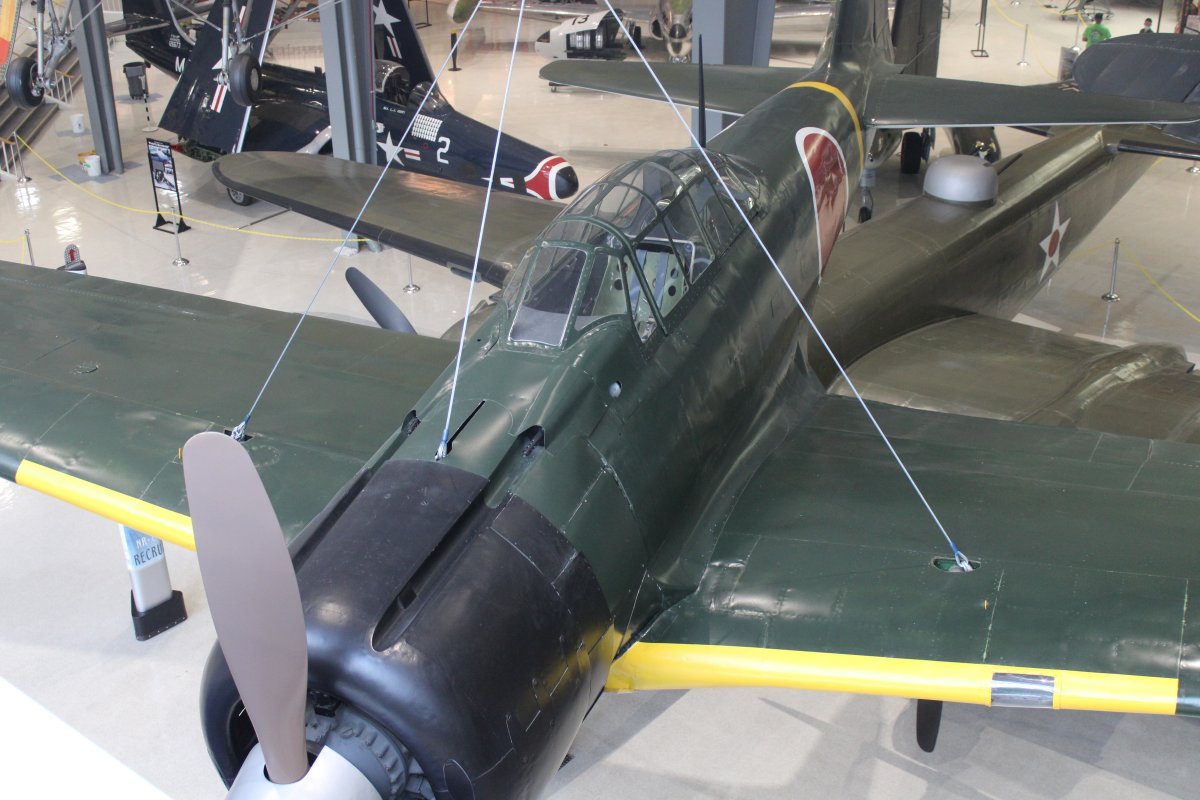 |
|
| Another Japanese fighter: the Shiden Kai N1K2-J or "George". Introduced in 1944, unlike the Mitsubishi A6M Zero, the Shiden Kai could compete against the best late-war Allied fighters, such as the F6F Hellcat, F4U Corsair, and P-51 Mustang. Only 1,532 were built, however. Compare that US Navy's F6F Hellcat, of which 12,275 were built in just over two years. |
| |
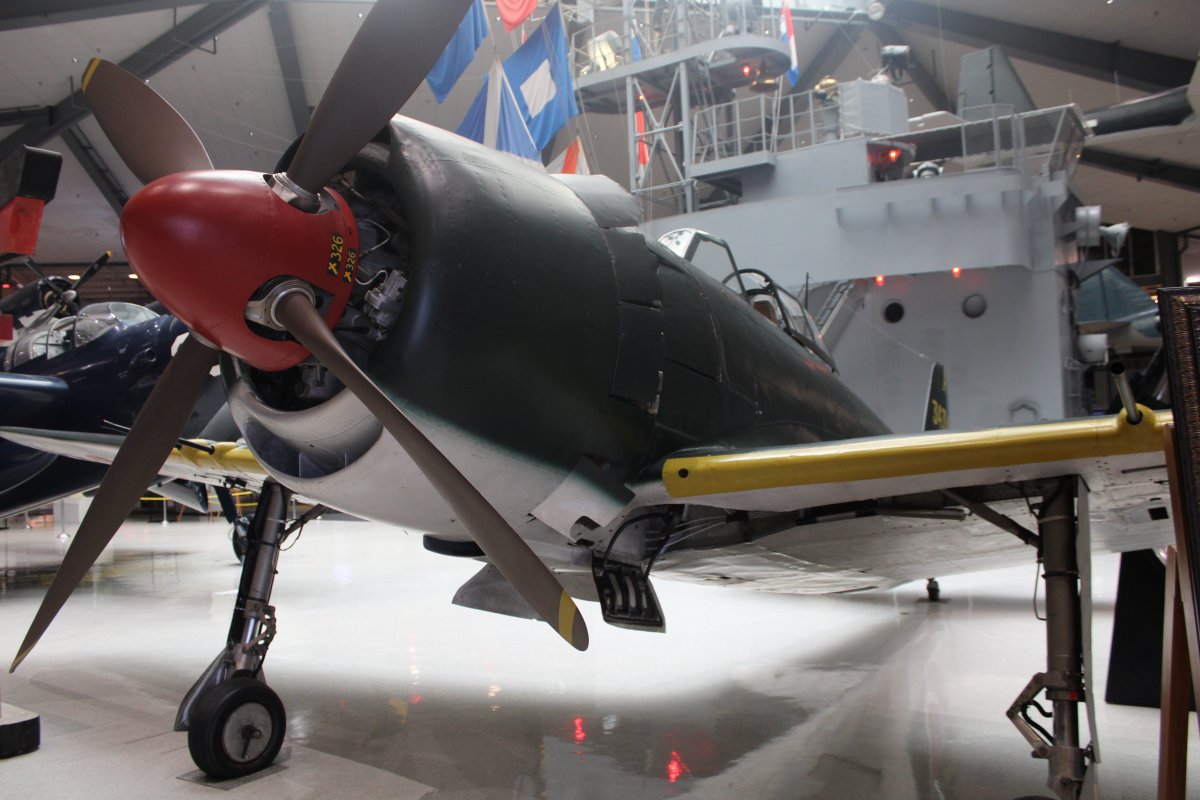 |
|
|
A two-seat version of the Me-262.
|
| |
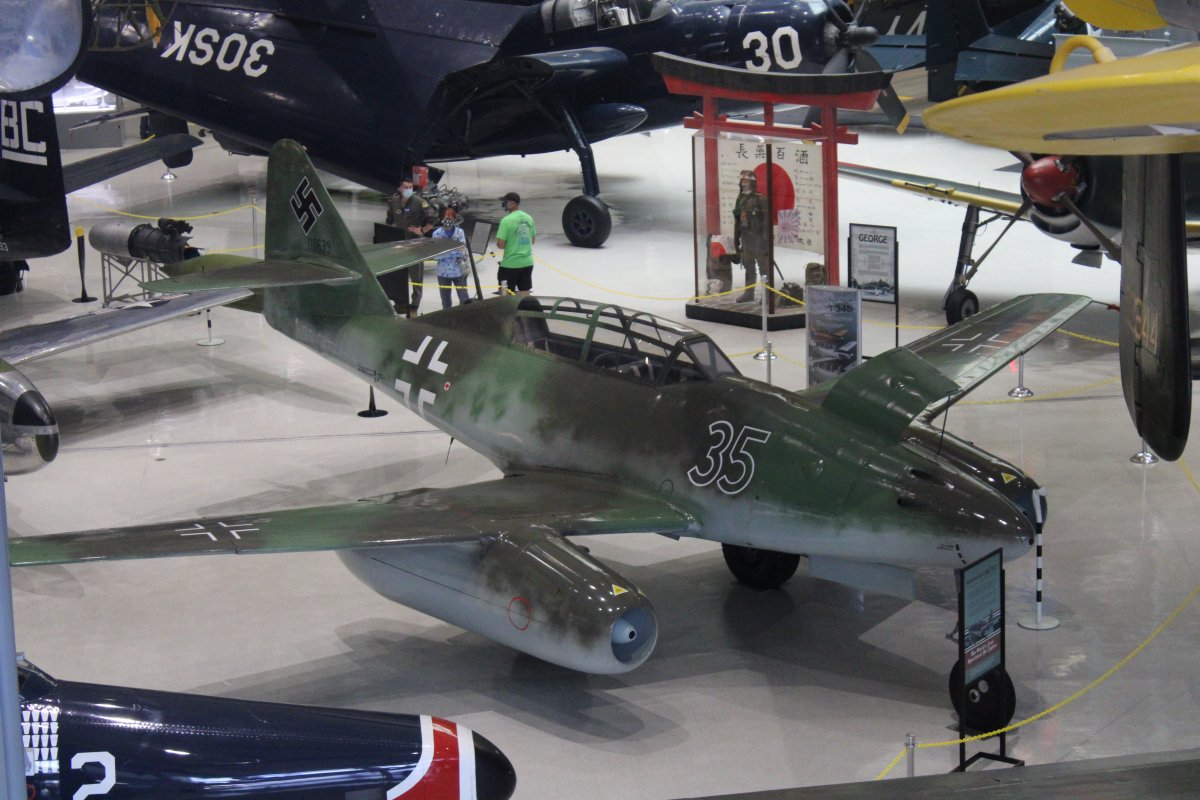 |
|
|
Looking across over to the new Wing.
|
| |
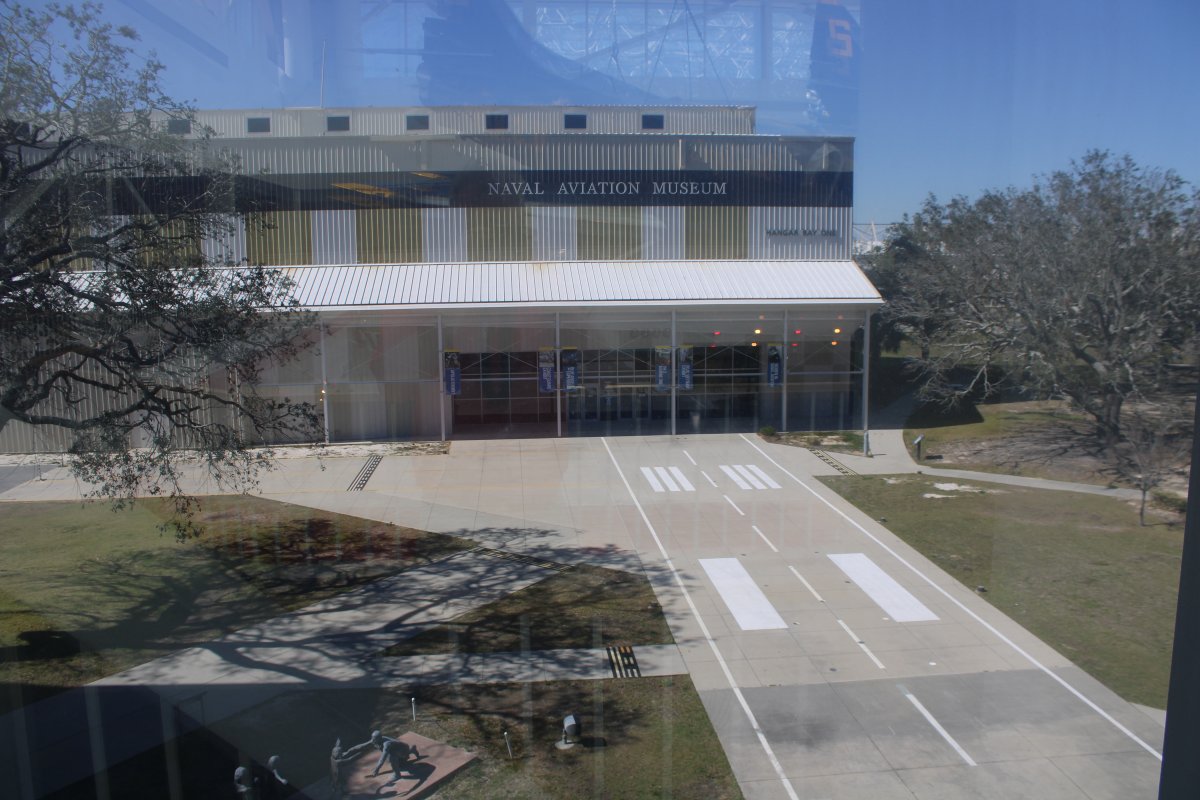 |
|
| A full-scale diorama of Navy mechanics working on a F6F Hellcat in the hangar bay of an aircraft carrier. |
| |
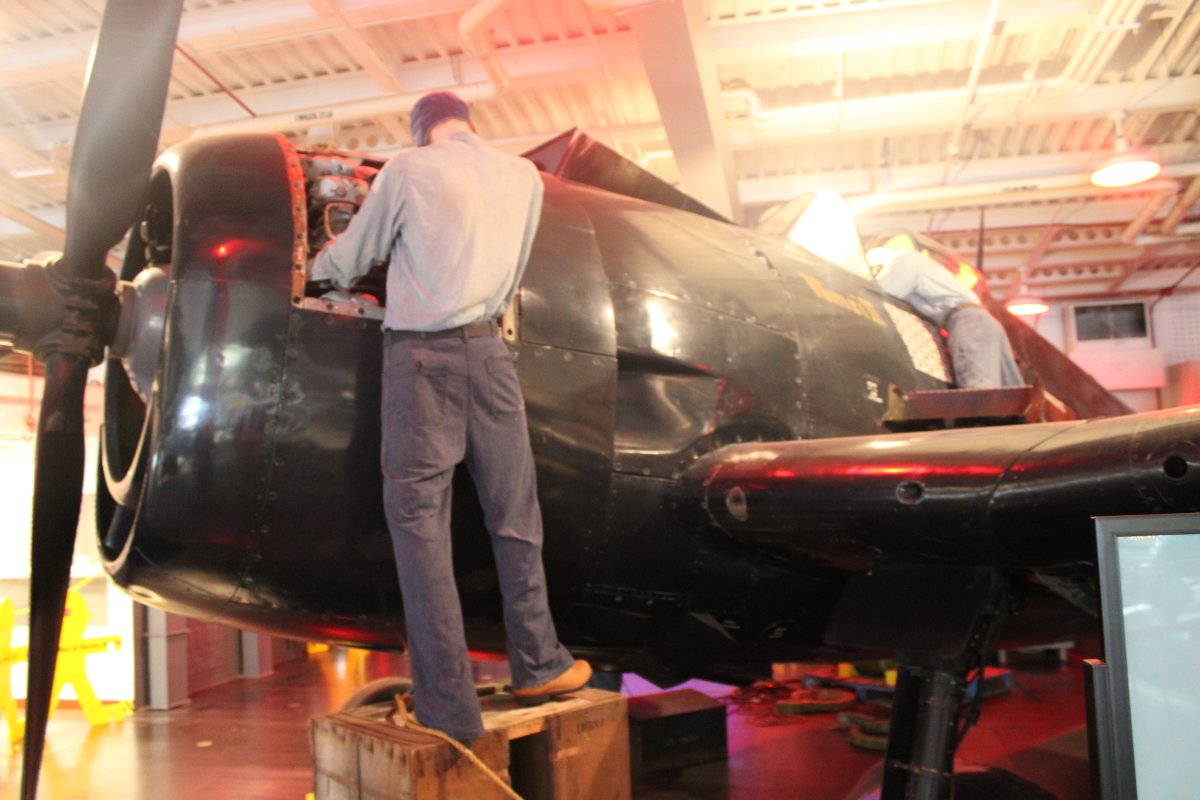 |
|
|
Another full-scale diorama of a well-used F4F Wildcat at Henderson Field on the south Pacific island of Guadalcanal. Notice the white Sagauro cactus painted on the cowl. The planes operating out of Henderson Field were called the Cactus Air Force. The term "Cactus" comes from the Allied code name for the island.
|
| |
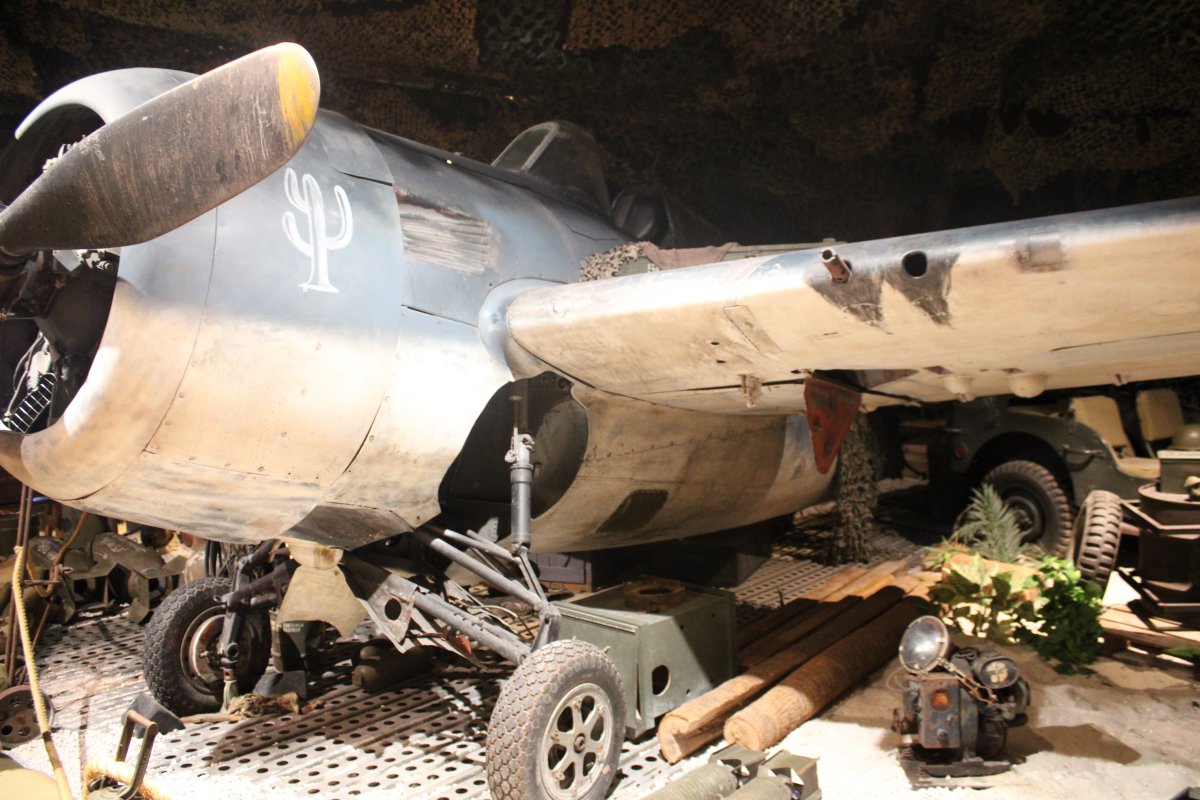 |
|
| This Grumman F3F-2 had ditched into the Pacific in 1940 while attempting a landing on USS Saratoga and was recovered in 1990, and restored by the San Diego Aerospace Museum. The F3F entered service in 1936 as the last biplane to be delivered to any American military air arm. It was retired from front line squadrons at the end of 1941 before it could serve in combat in World War II. The F3Fserved as the basis for a biplane design ultimately developed into the much more successful F4F Wildcat. 147 were built. |
| |
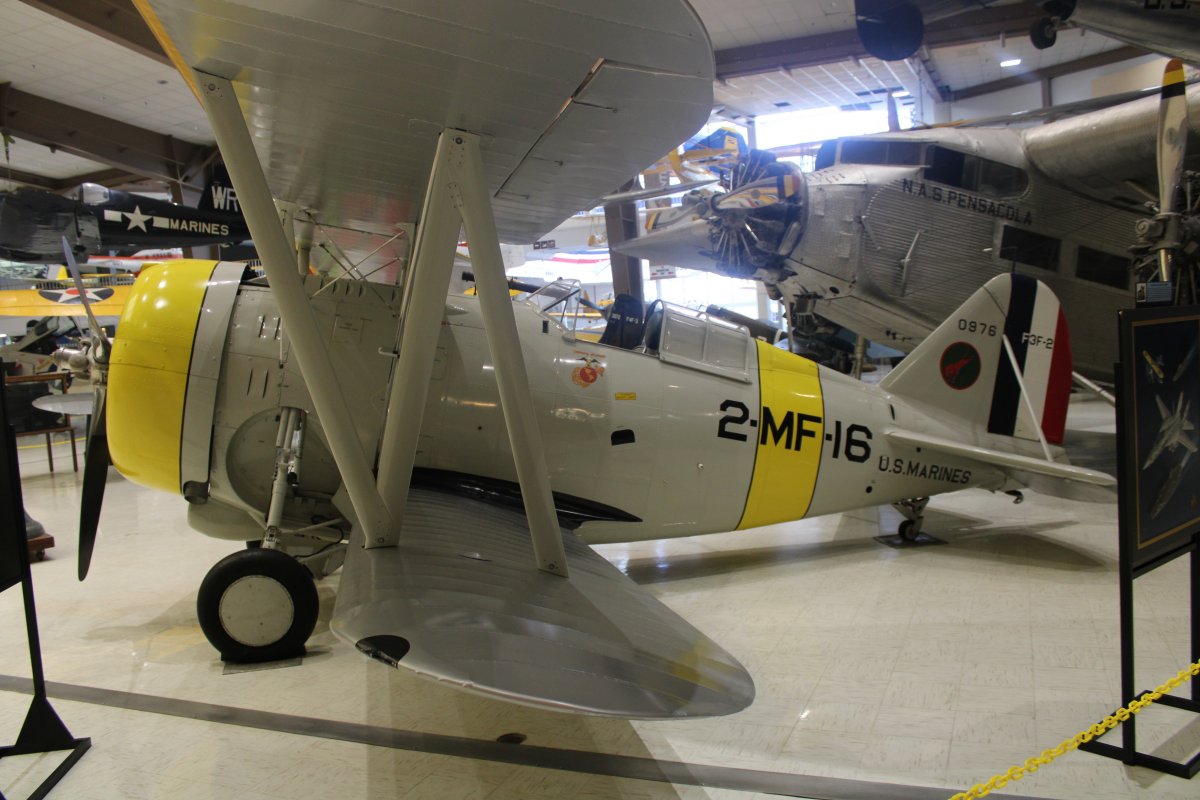 |
|
| Probably the flagship of the museum's collection is the enormous Navy-Curtiss Flying Boat. This particular aircraft was NC-4, which was the only one of three NC Flying Boats to make it across the Atlantic Ocean in May 1919. NC-4 was commanded by Lieutenant Commander A.C. Read. |
| |
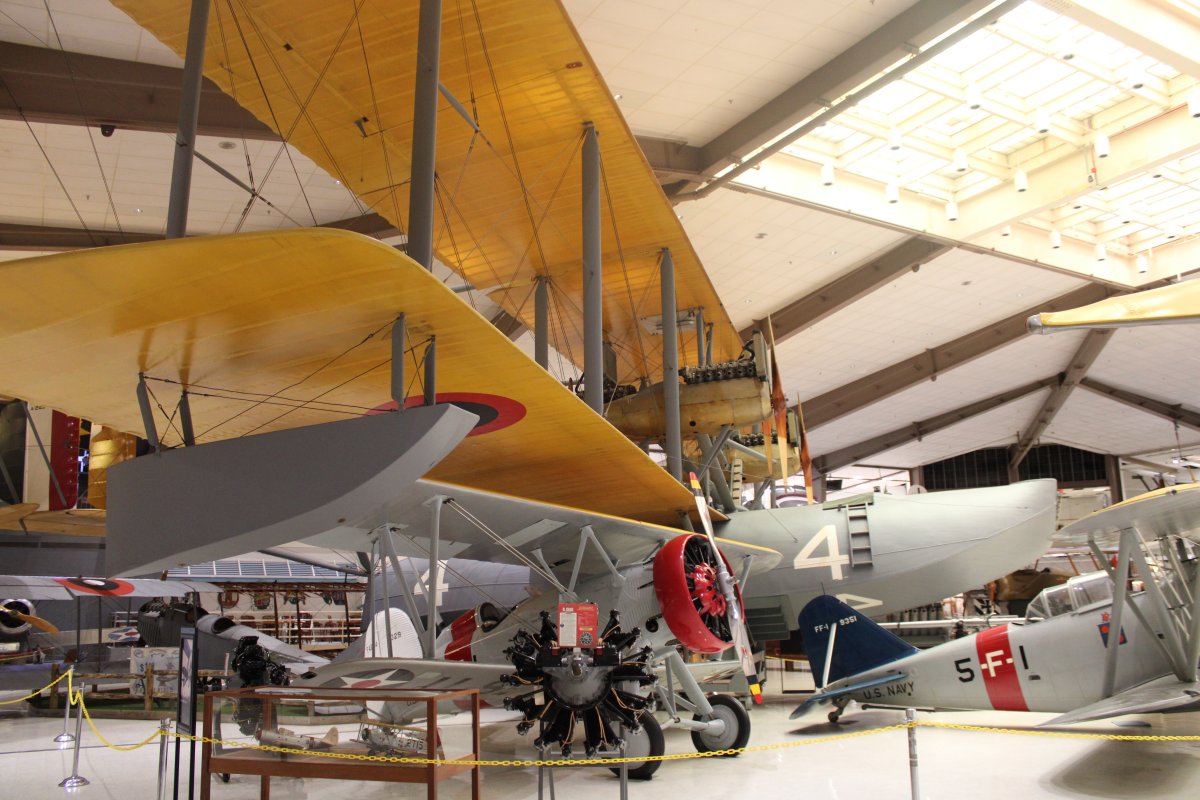 |
|
| A good look at the four engines carried by the NC. The NC was originally powered by three V12 Liberty engines, of 400 hp each; during the testing phase the addition of a fourth engine to help create enough power to lift the boats out of the water was recommended. The fourth engine was added to the midline in a pusher configuration. |
| |
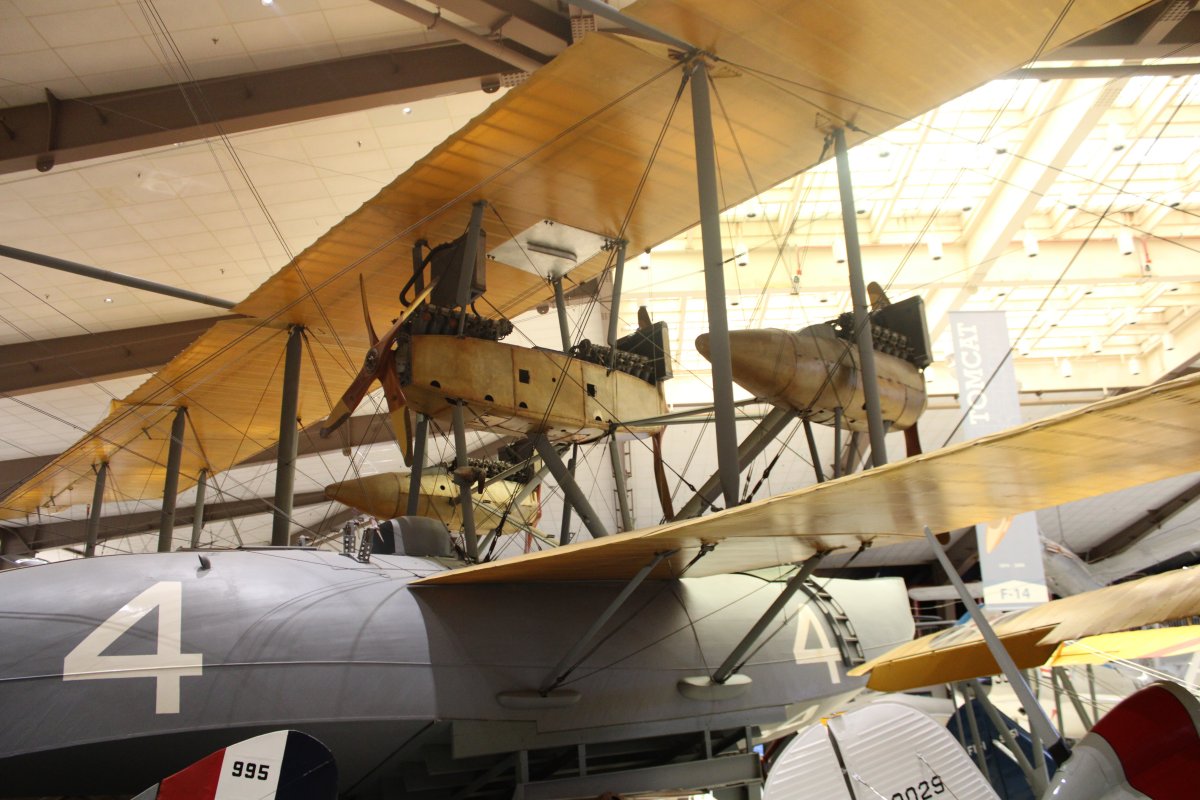 |
|
|
The NC was used by the United States Navy from 1918 through the early 1920s. Ten of these aircraft were built.
Maximum speed was 85 mph; stall speed was 62 mph! Service ceiling was only 4,500 feet.
In May 1919, a crew of United States Navy and US Coast Guard aviators, commanded by LCDR A.C. Read, flew the NC-4 from New York State to Lisbon, Portugal, over the course of 19 days. This included time for stops of numerous repairs and for crewmen's rest, with stops along the way in Massachusetts, Nova Scotia (on the mainland), Newfoundland, and twice in the Azores Islands. Then its flight from the Azores to Lisbon completed the first transatlantic flight between North America and Europe, and two more flights from Lisbon to northwestern Spain to Plymouth, England, completed the first flight between North America and Great Britain. This accomplishment was somewhat eclipsed in the minds of the public by the first nonstop transatlantic flight, made by the Royal Air Force pilots John Alcock and Arthur Whitten Brown two weeks later.
A.C. Read achived rank of Rear Admiral during World War II and commanded Naval Air Station Pensacola from 1940-42. The golf course at NAS Pensacola is named after him.
|
| |
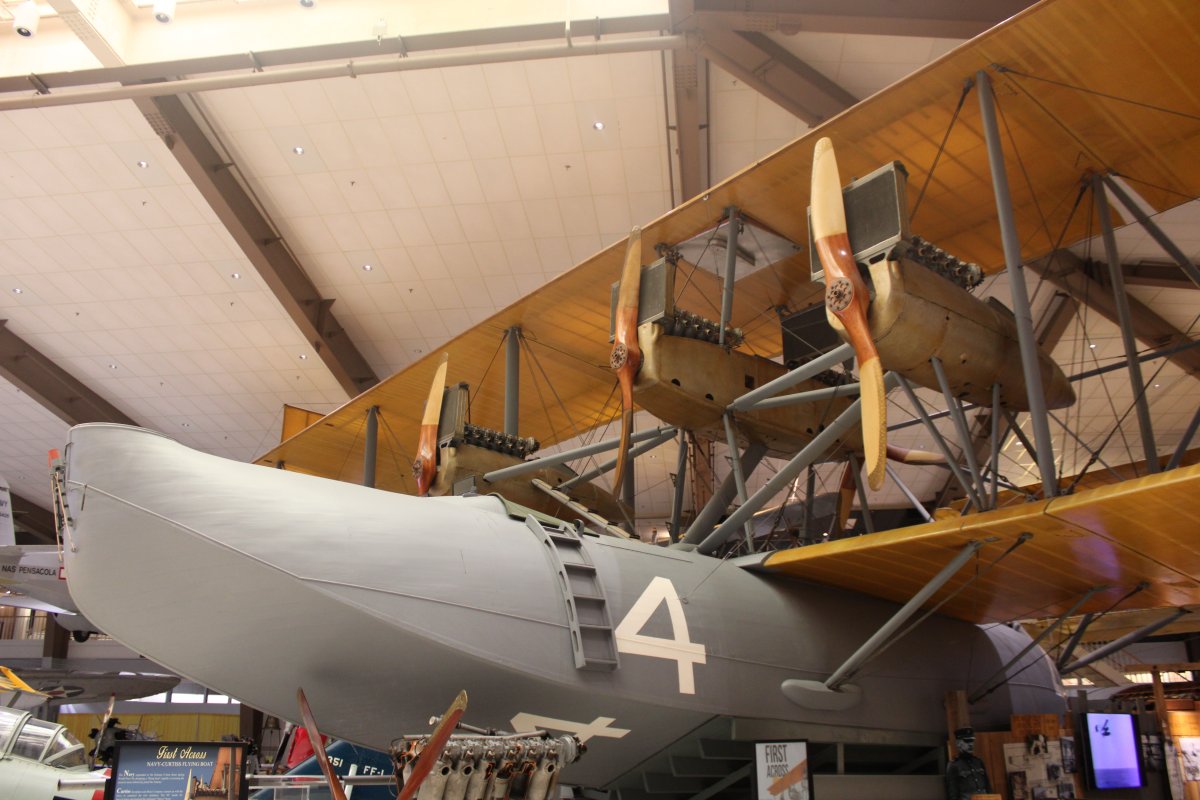 |
|
|
The NC-4 is property of the Smithsonian Institution, since it was given to that institution by the Navy after its return home. As of 1974, the reassembled NC-4 is on loan from the Smithsonian to the National Museum of Naval Aviation in Pensacola, Florida.
|
| |
 |
|
|
An immaculate, and relatively unknown Grumman AF Guardian. The Guardian was the first purpose-built anti-submarine warfare (ASW) carrier-based aircraft to enter service with the United States Navy. It consisted of two airframe variants, one for detection gear, the other for weapons. The Guardian remained in service until August 1955, when it was replaced by the twin-engined Grumman S-2 Tracker. The Guardian was the largest single-engine piston-powered carrier aircraft ever to see service.
Making its first flight on 19 December 1945, the Guardian was made operational in 1950 and retired in 1955. 389 were built. The Guardian was powered by a Pratt & Whitney R-2800-48W "Double Wasp" radial engine with 2,400 hp.
On 24 December 1945, the Navy changed the role of the aircraft from torpedo-bomber to anti-submarine warfare. All the required equipment could not be fitted into a single aircraft, consequently two variants would be produced, one as a "guppy" (hunter) and another as a "scrapper" (killer).[6] The hunter aircraft would not carry any armament, but instead carried two additional crew members, a search radar, and electronic countermeasures (ECM) equipment.
The Guardian saw service in the maritime patrol role during the Korean War, however it proved unpopular with pilots, being underpowered and heavy on the controls; the aircraft suffered from a severely high accident rate. VAdm James B. Stockdale flew the Guardian early in his Navy career.
This aircraft was the seventh AF-2S (killer) produced. After its naval service it was used to fight fires until 1978.
I saw one of these at the Pima Air Museum last November but it sat outside and was nowhere near as nice as this one.
|
| |
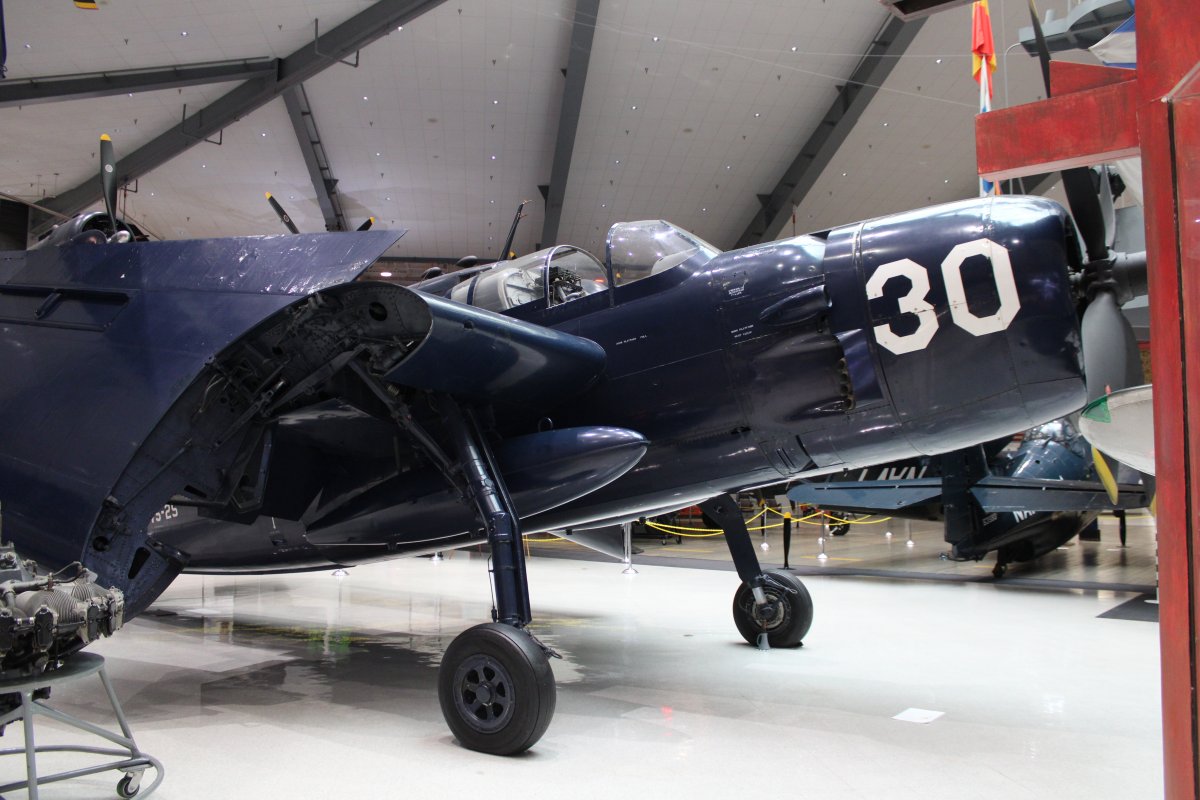 |
|
|
I really liked this painting with all the U.S. Navy's main aircraft as well as the aircraft carrier types at bottom. The venerable P-3 even made the picture.
|
| |
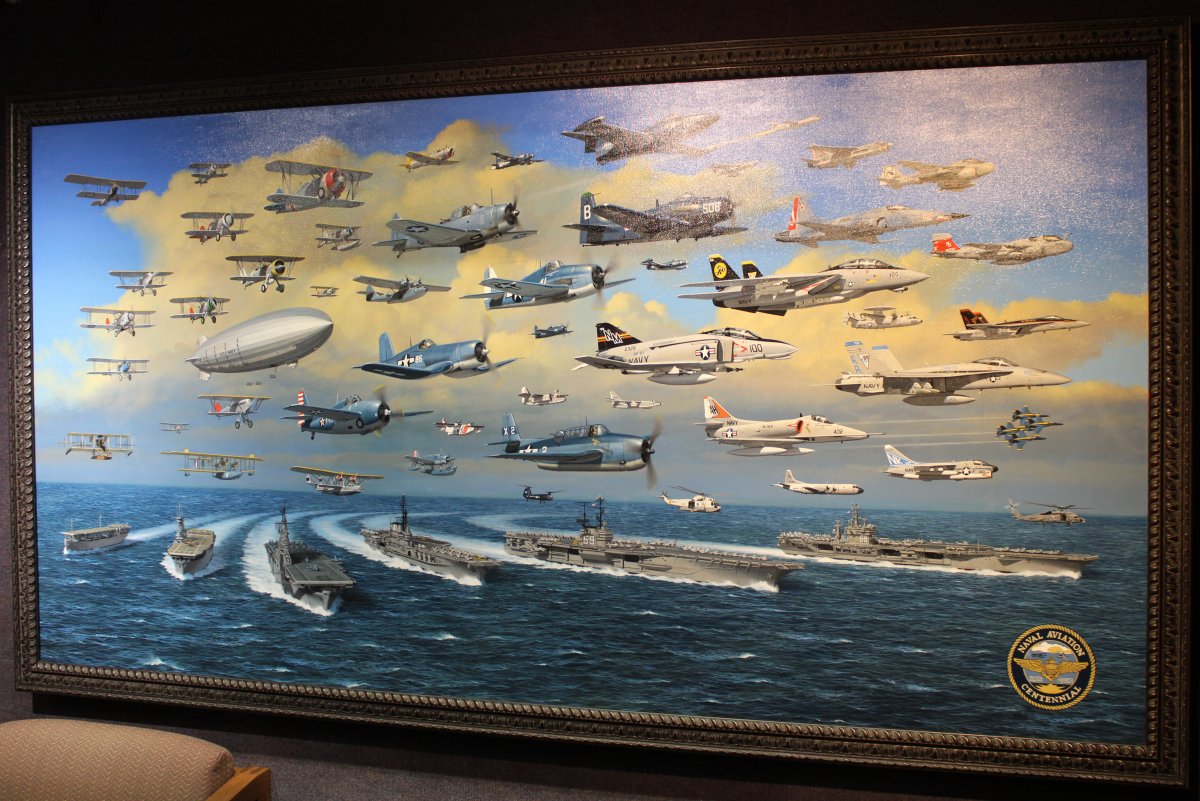 |
|
| Looking down at the main US Navy fighter of World War II: the Grumman F6F Hellcat. |
| |
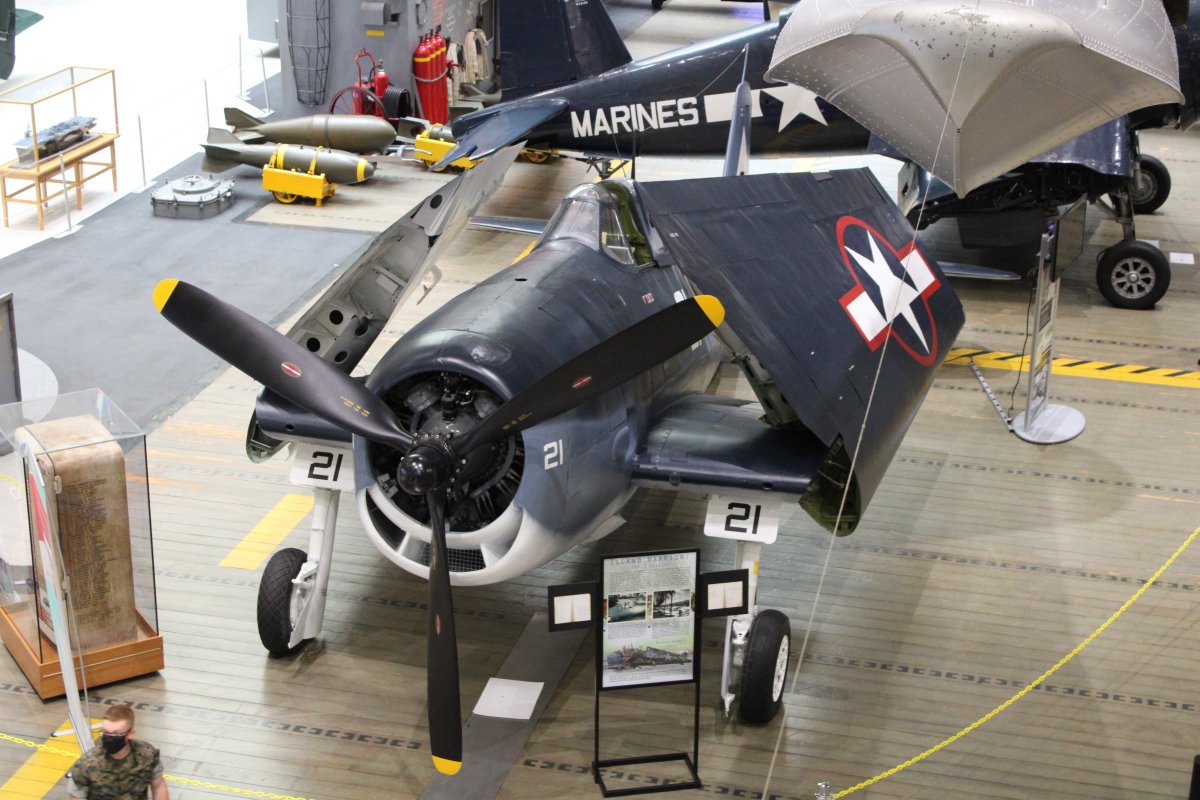 |
|
| Even with the new wing, the Naval Aviation Museum seems a little crowded. It's a shame to have to display a plane with the wings folded. That's a F4U-Corsair on the left, Grumman F8F Bearcat on the right. |
| |
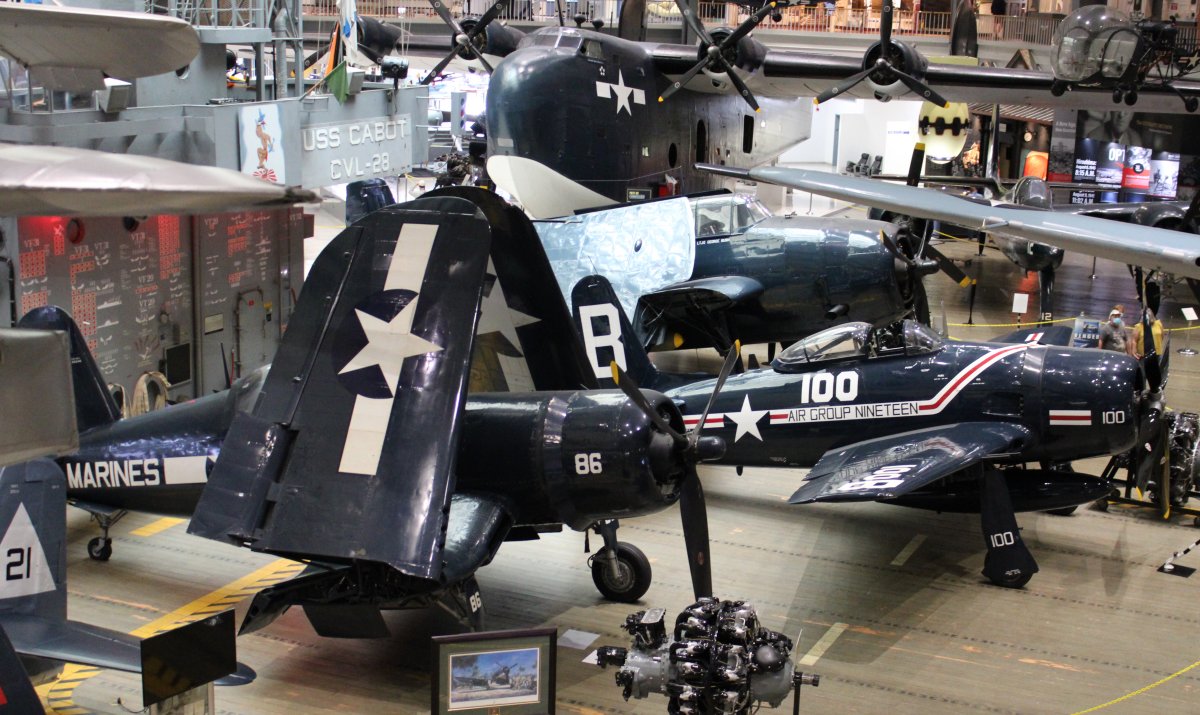 |
|
|
The Bearcat deserves a better look.
|
| |
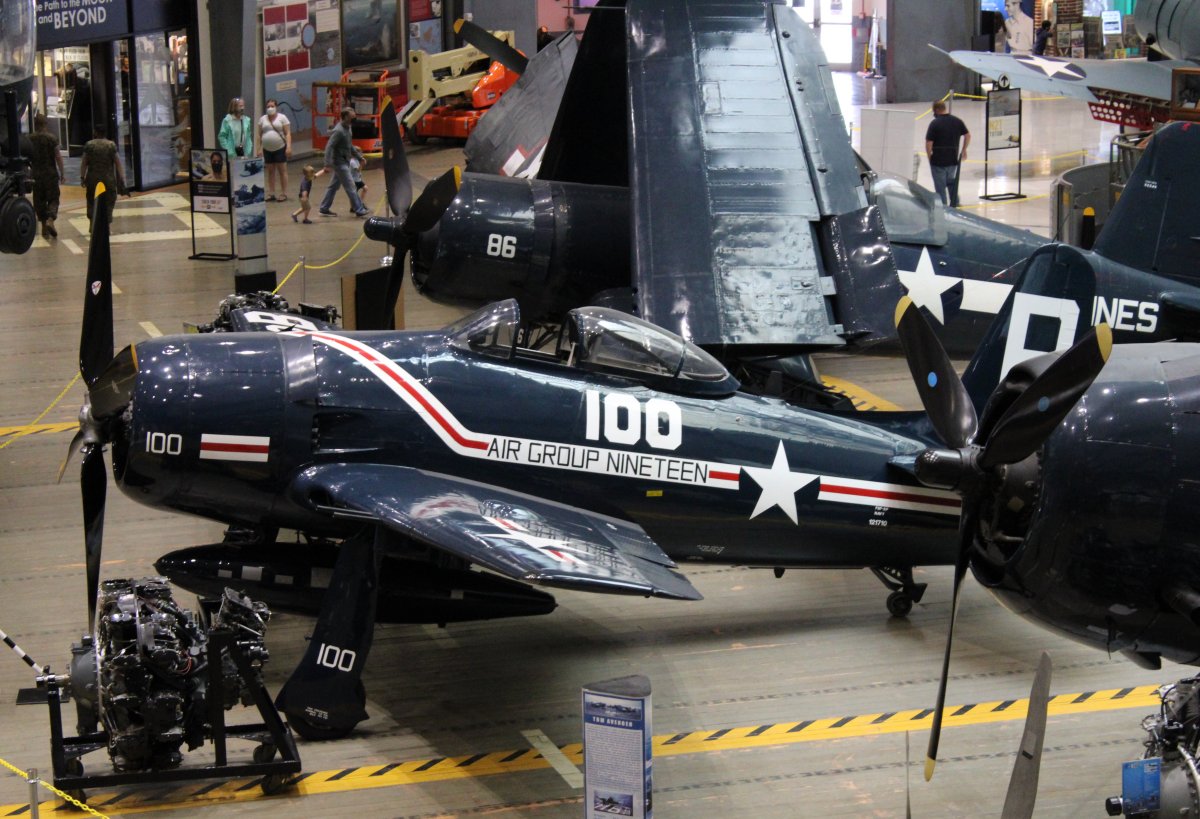 |
|
|
A massive Consolidated PB2Y Coronado flying boat dominates this area. 217 were built; most served as transport and hospital aircraft. This is the only one left.
This particular aircraft served as a Flag Transport. I believe Commander-in-Chief, Pacific Fleet, Admiral Nimitz flew around in this aircraft. After the war, the aircraft was bought by Howard Hughes. It took the Naval Aviation Museum 13 years to restore this aircraft.
|
| |
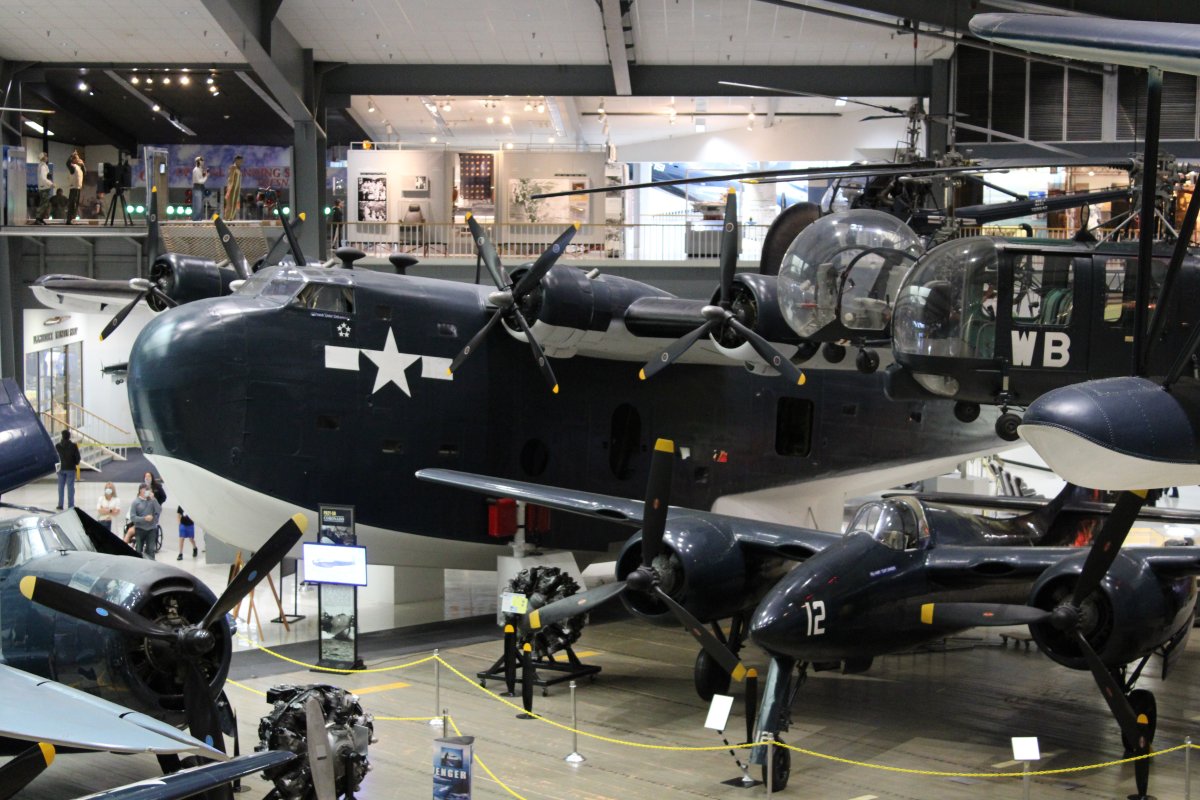 |
|
Looking down at a nice P-40 Warhawk in the markings of the American Volunteer Group (Flying Tigers), Chinese Air Force. Not considered that good of fighter in World War II, nevertheless, 13,278 were built and they fought in almost every theatre of the war and for all the allies: Americans, British, Soviets, Chinese, French, etc. |
| |
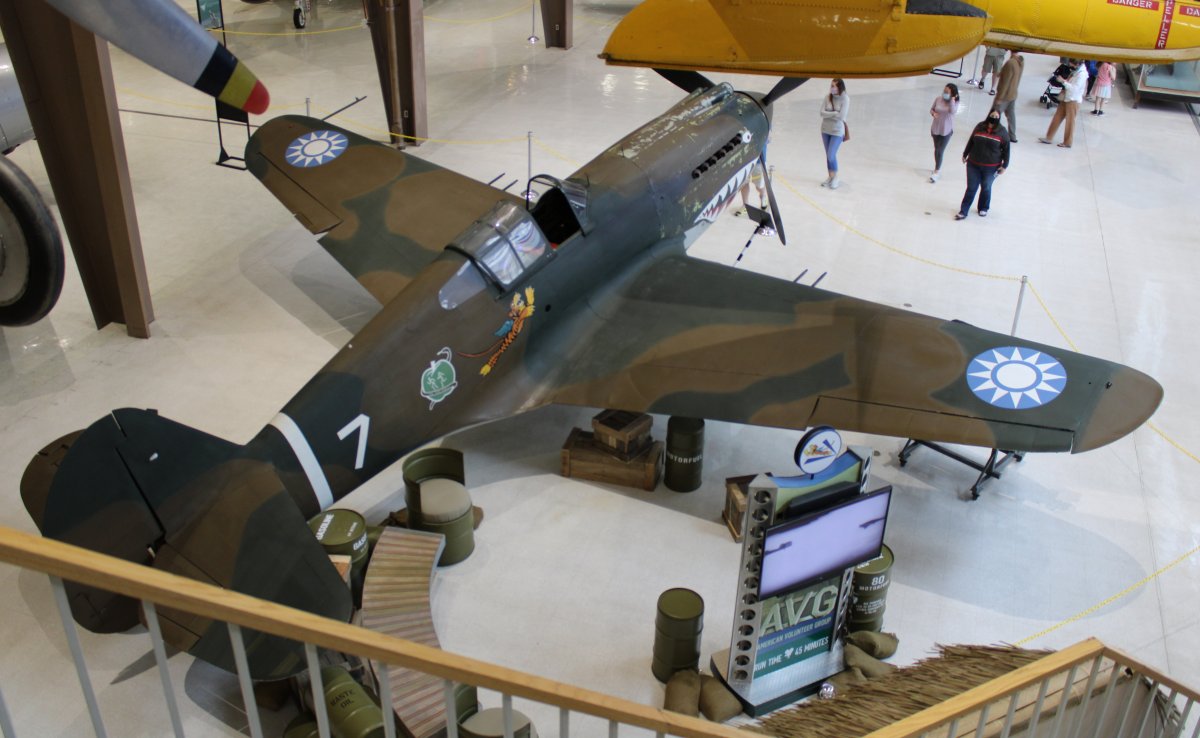 |
|
| This brightly painted Wildcat is a rare Grumman-built F4F-3. Unlike most Wildcats, its wings do not fold. |
| |
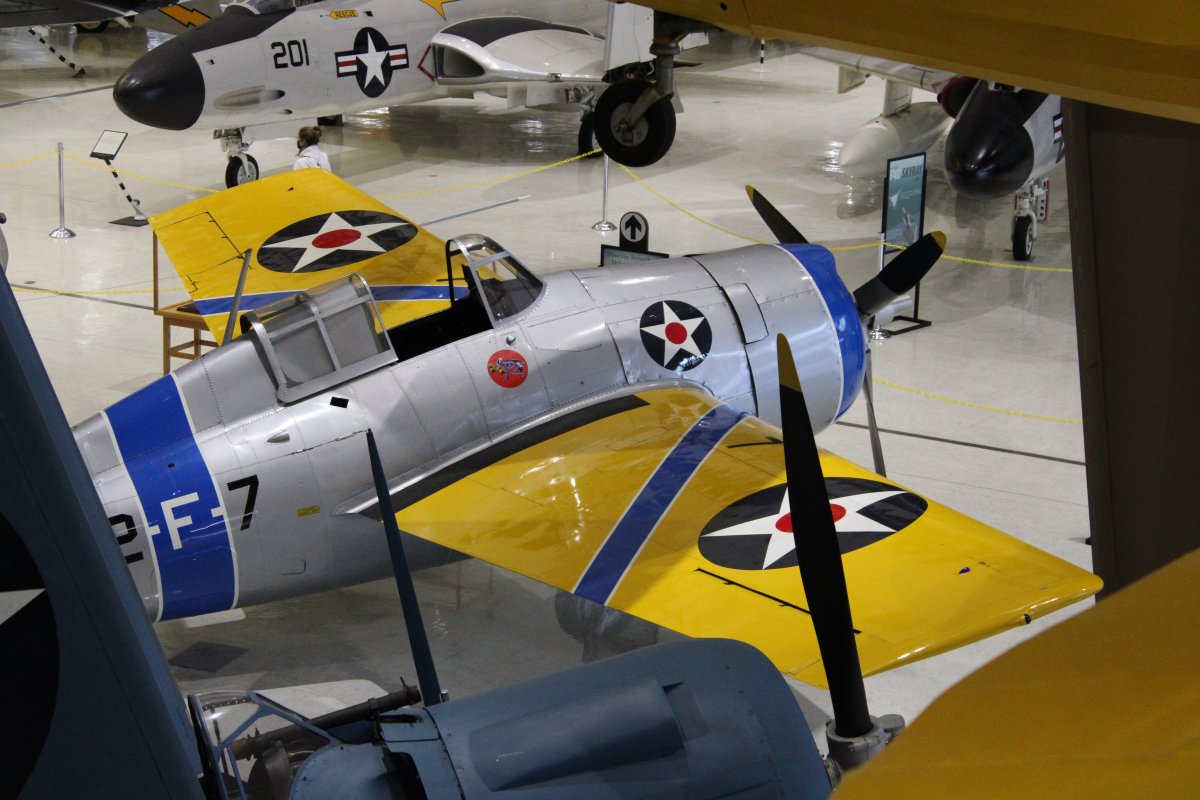 |
|
A painting of a North American T-2 Buckeye. I had five flights in one of these during my Naval Flight Officer training back in early 1982. The Navy retired this jet in 2008, replacing them with the T-45 Goshawk. A number of T-2s are now owned privately and you see them occasionally at an airshow or fly-in |
| |
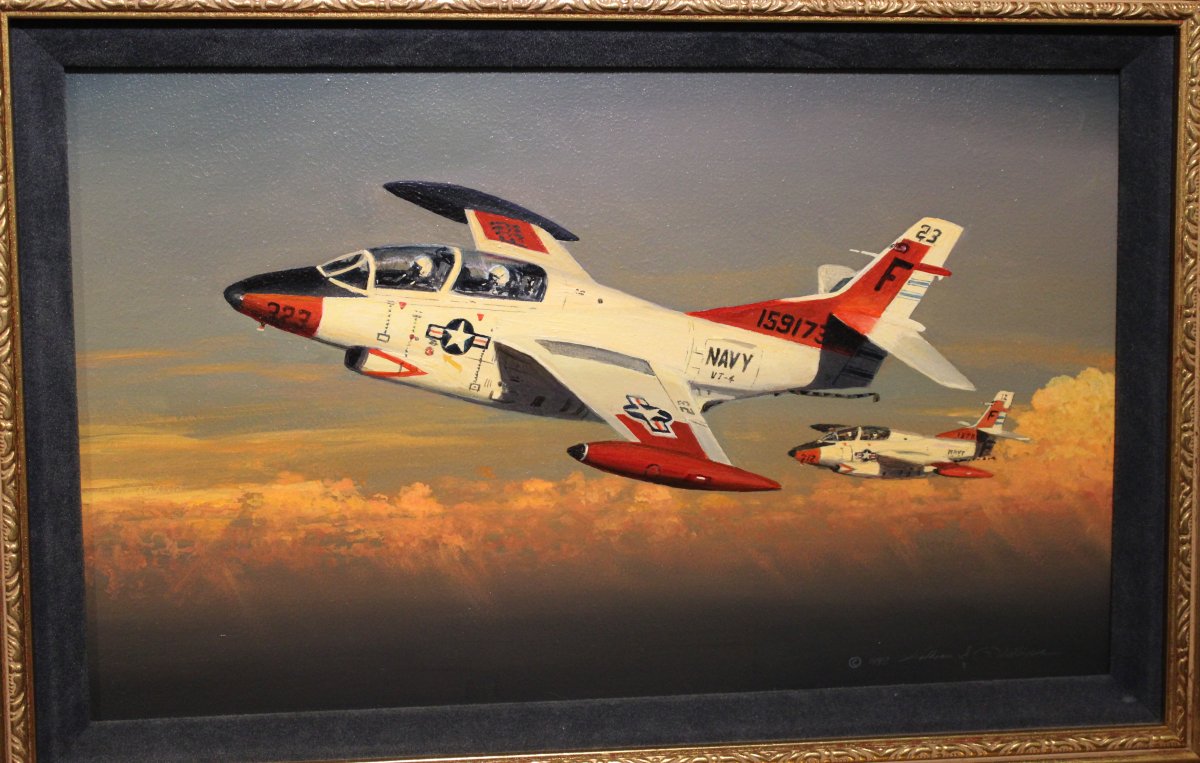 |
|
| A painting of a Douglas TBD Devastator, the US Navy's torpedo bomber in the first six months after Pearl Harbor. The Devastators were, well, devastated by the Japanese at the Battle of Midway in which 41 Devastators recorded zero torpedo hits with only six surviving to return to their carriers. Faulty aerial torpedoes didn't help the Devastator's cause. The Devastator was withdrawn from frontline service after Midway, being replaced by the Grumman TBF Avenger. Only 130 were built and there are no surviving examples, although the USS Midway Museum in San Diego has a 1:1 scale replica used in the World War II movie, Midway. |
| |
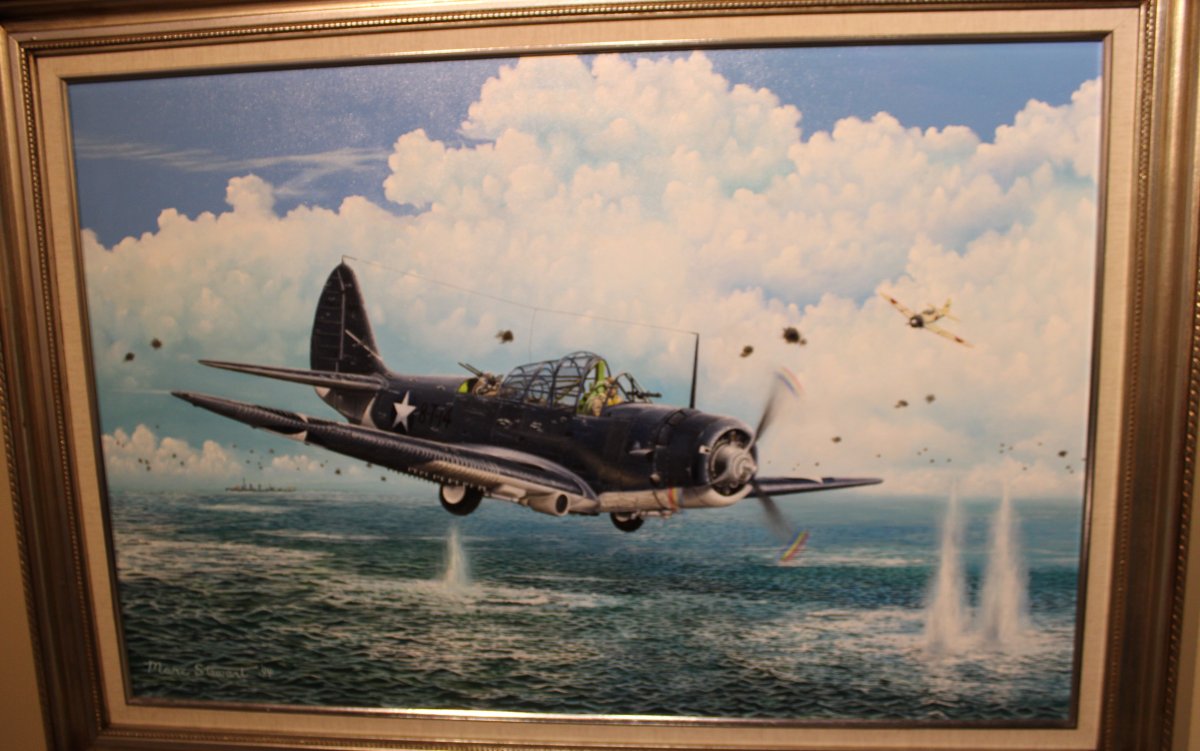 |
|
| Regretfully, there isn't a P-3 in the museum's collection (at least not displayed inside or outside that I could see -- I'm sure they have one somewhere), but they did have this painting of a P-3 on top of a surfaced Soviet nuclear submarine. |
| |
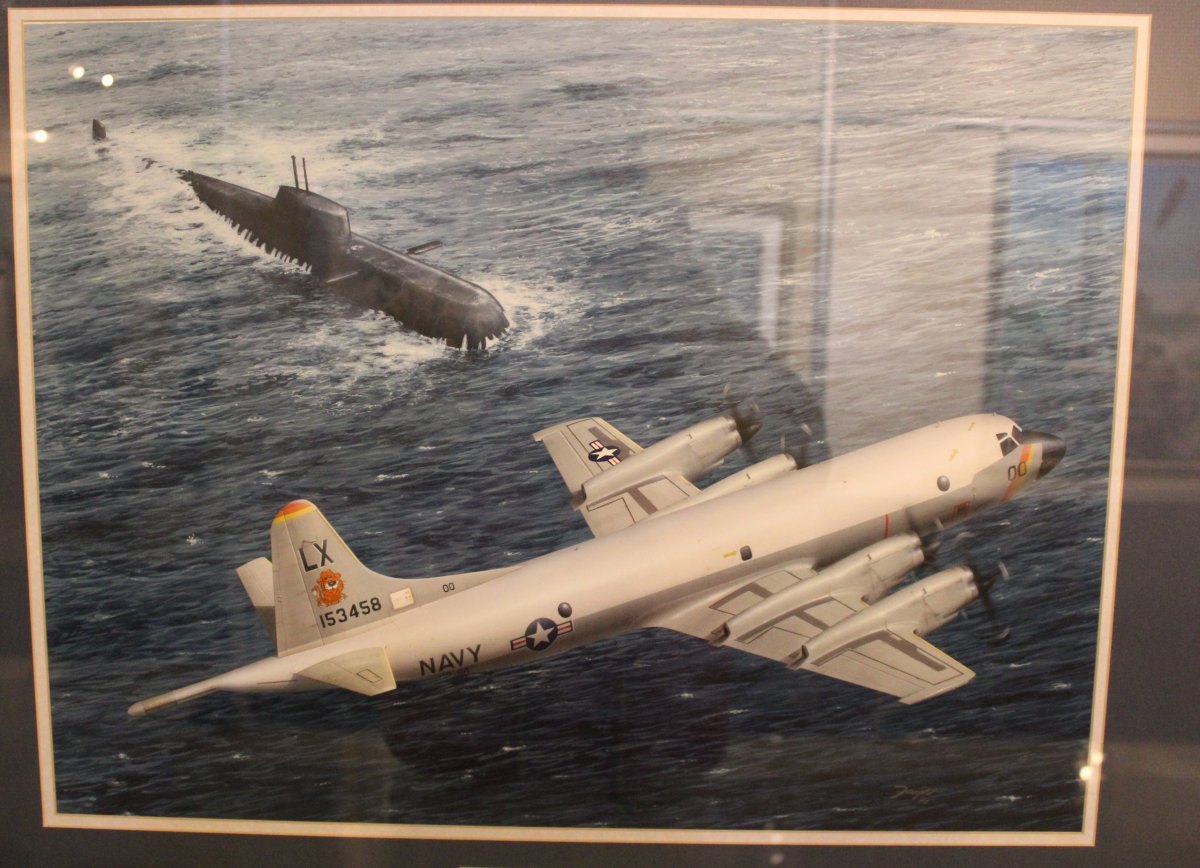 |
|
| Following the Navy's decision to use only air-cooled radial engines instead of liquid-cooled in-line engines which had proved difficult to maintain at sea, the Curtiss F7C Seahawk was developed. It was powered by a 450 horsepower Pratt and Whitney R-1340-B Wasp. First flown in 1927, the F7Cs were used only by a Marine Corps squadron based at Quantico until 1933. Only 17 Seahawks were built. Max speed was 155 mph. |
| |
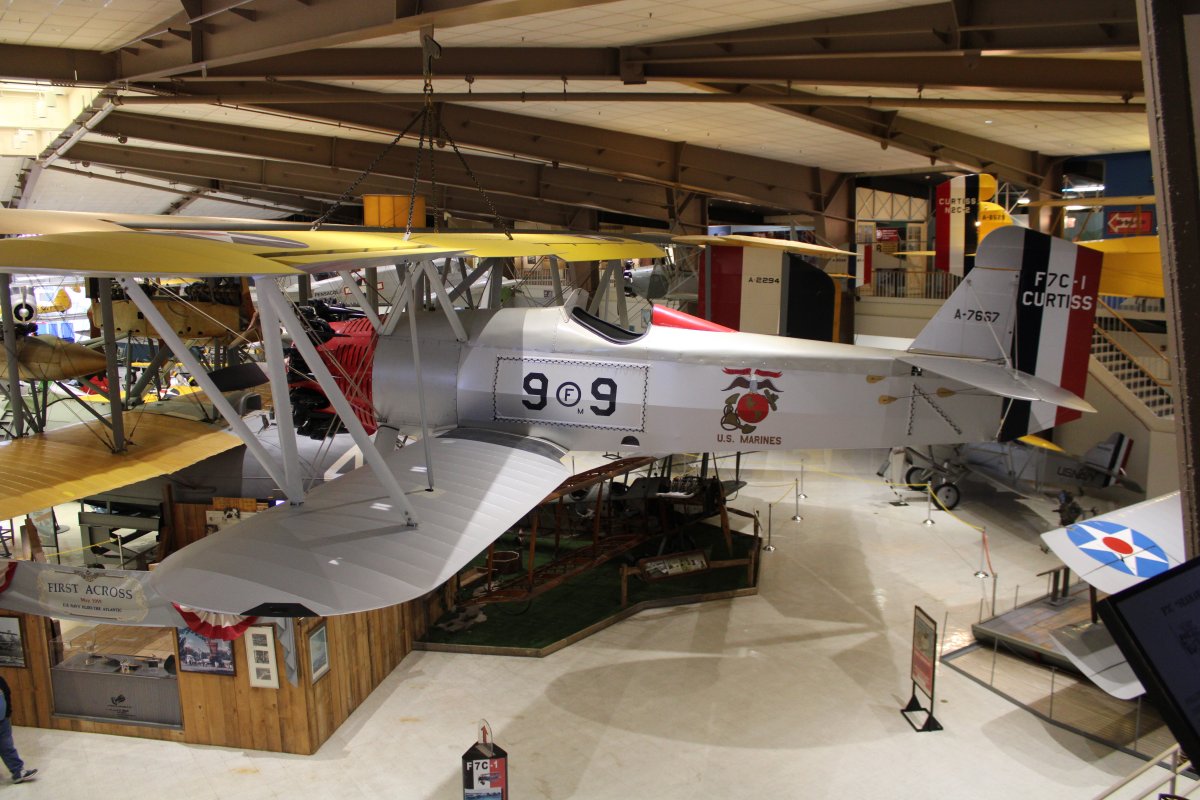 |
|
| The straight wing Grumman F9F-2 Panther, the US Navy's first successful carrier-based jet fighter. The Panther was used extensively by the U.S. Navy and Marine Corps in the Korean War. It was heavily armed with four 20 mm cannon and could carry a wide assortment of air-to-ground munitions. Neil Armstrong, John Glenn and Ted Williams all flew the Panther, as well as the Blue Angels. |
| |
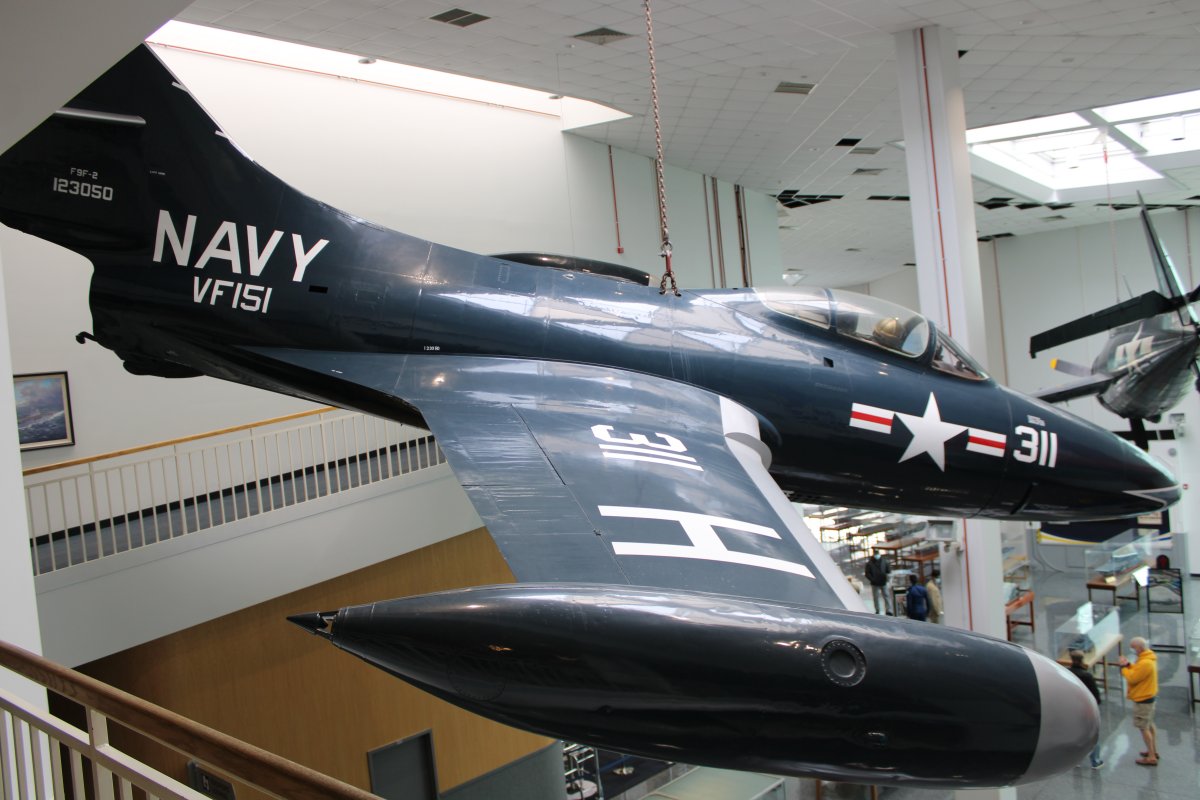 |
|
| Then there was the Grumman F9F-6 Cougar which had swept wings. Thrust was also increased over the Panther with the installation of a newer, more powerful engine. The Cougar arrived too late to the Korean theater to participate in the air war. F9F-8s were withdrawn from front-line service in 1958–59, replaced by F11F Tigers and F8U Crusaders. The Naval Reserves used them until the mid-1960s, but none of the single-seat versions were used in the Vietnam War. |
| |
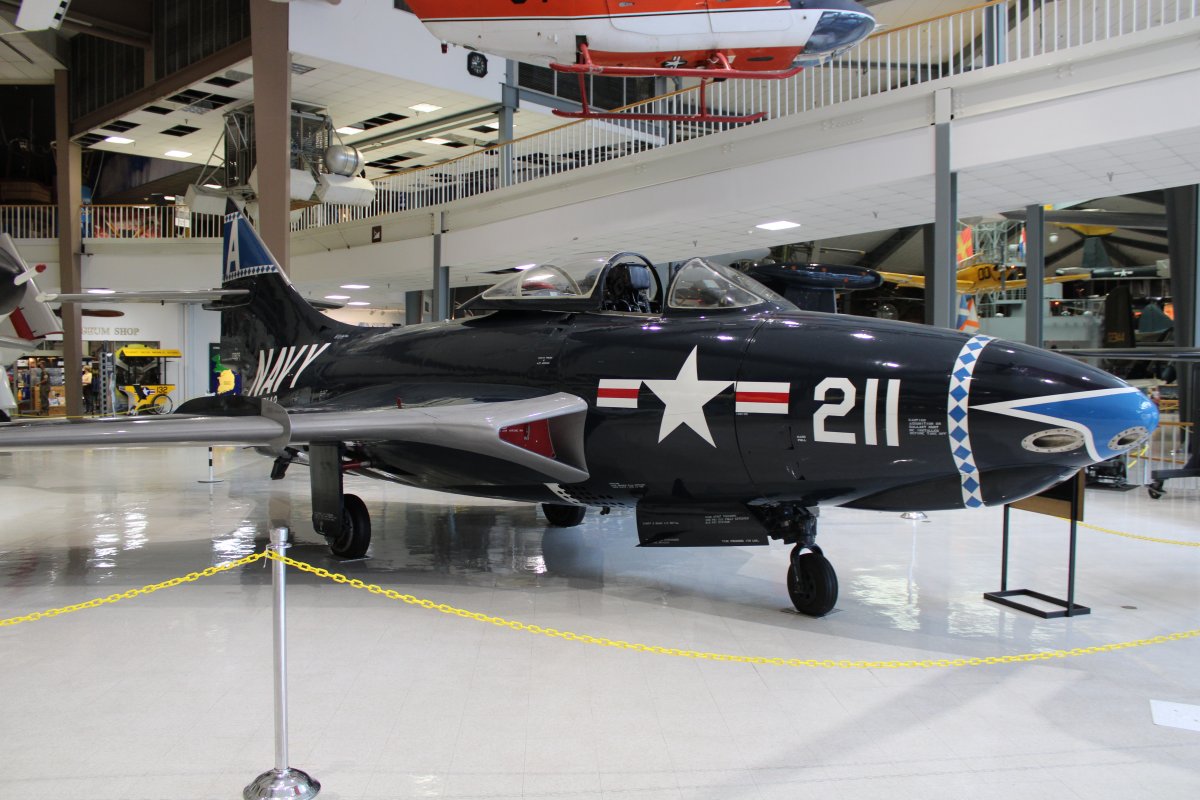 |
|
An immaculate Curtiss BFC-2 Goshawk. The Goshawk, operational in the US Navy during the mid-30s, was produced in low numbers -- 28 -- but was an important link in the evolution of Navy aircraft. The partial canopy, large powerful engine, dual fighter and bomber roles, and armament carrying capabilities were among the innovations peculiar to the aircraft.
The Goshawk actually flew combat in World War II, operated by the Chinese Nationalist Air Force against the Japanese. Germany actually bought two of them for evaluation as dive bombers, and one of them is now on display in the Polish Aviation Museum.
|
| |
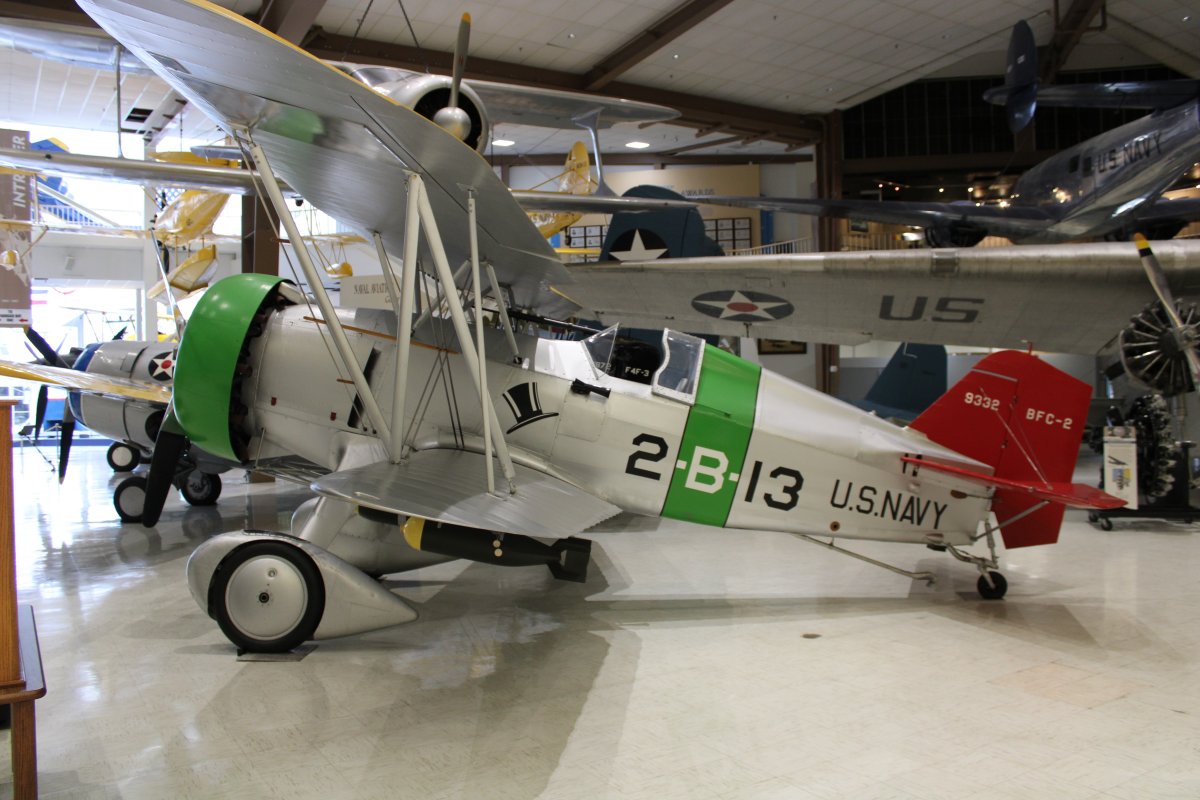 |
|
| |
| |
|
|
|
|
|
|






















































